

The Paine 14 – A Herreshoff – inspired daysailor
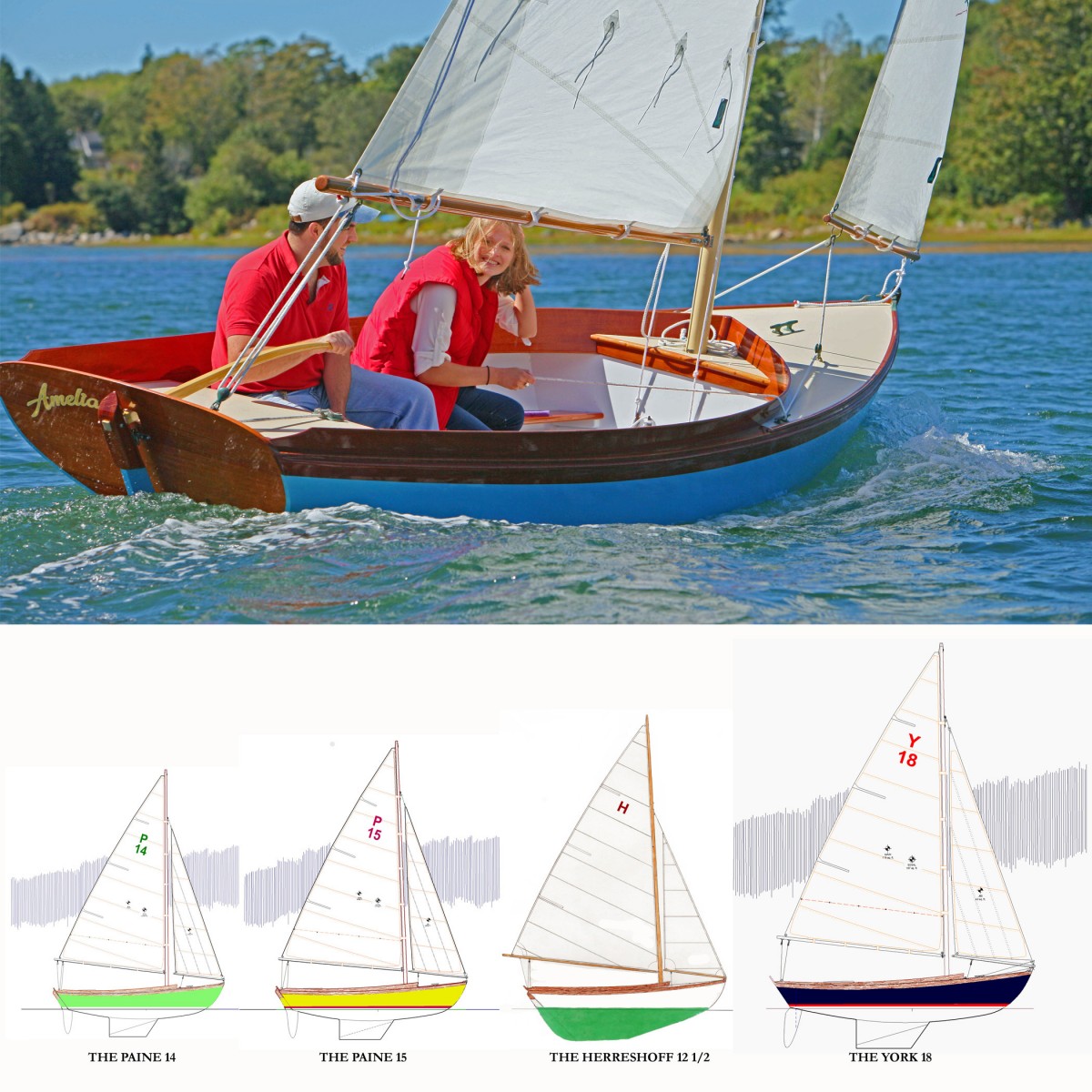
CHUCK PAINE’s FLEET OF MODERN KEELBOAT DESIGNS. And their progenitor, the wonderful Herreshoff 12 1/2.
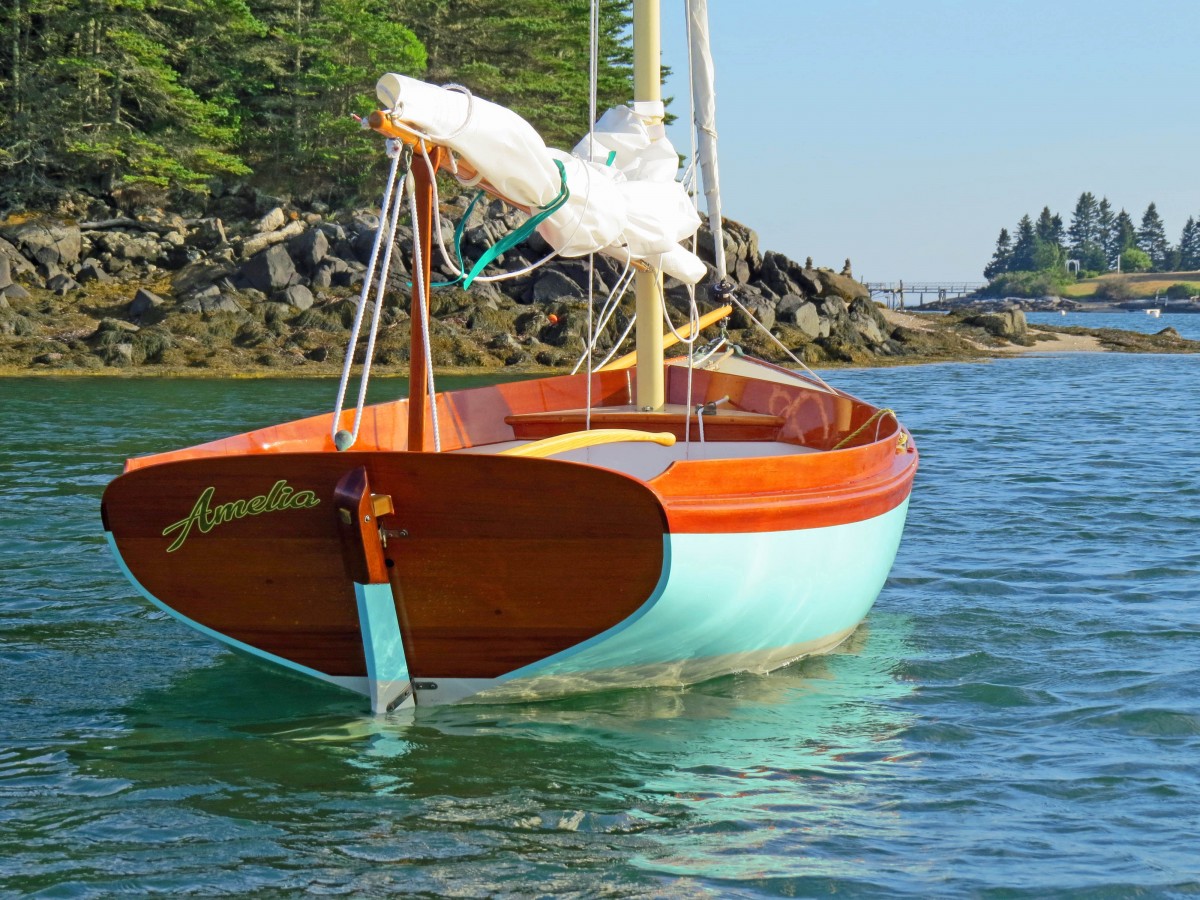
Unlike most centerboard boats of this size, she can be kept on a mooring. Many centerboard boats will capsize in a squall.
Tired of owning and spending lots of money on a boat you never have time or available crew to enjoy? Read on. If you have a length restriction at 14 feet, this is the sailboat you’ll actually USE. (It has been largely supplanted by the LEVANT 15, which is larger and faster and owing to investments made by its builder, even cheaper) The PAINE 14 is a scaled-down adaptation of the venerable and much-loved Herreshoff 12 1/2, with a much lower wetted surface hull, fin keel, carbon fiber mast and separate rudder. They are now built in seamless epoxy cold-molded wood construction at French & Webb Boatbuilders, Inc. of Belfast, Maine. At approximately 10% smaller in length, breadth and depth, she preserves much of the “big boat” feel of her predecessor thanks to a lead ballast keel that accounts for nearly half her entire weight, but is optimized for easy trailering, maintenance, launch and retrieval, and home-stowage in your garage. The prototypes shown in these photos have been built and tested, many small refinements have been made, and the boat is now in a word, perfect. The PAINE 14 may be either gaff or marconi rigged though for quick setup and takedown and an edge in performance, the latter is preferable. The size of this design was chosen for its ability to be easily lifted and stowed on the deck of a motoryacht… without this limitation the larger Levant 15 and York 18 might probably be the better choices.
Want to know just how fast a PAINE 14 is in light airs? Watch the video below. In her appearance she pays homage to her predecessor, Chuck Paine’s 83- year old Herreshoff 12 1/2. Then you’ll see that like the very best boats, she is so fast she “makes her own wind” when going to windward in light airs.
Amelia from Jim Dugan on Vimeo .
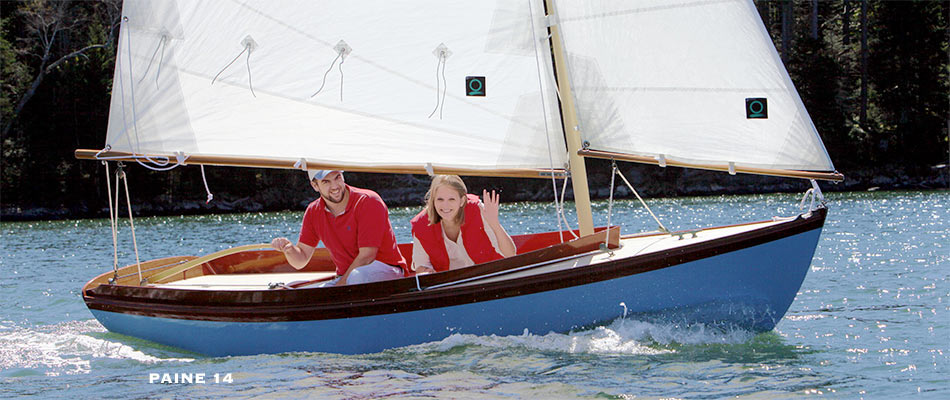
You just can’t slow this beauty down! And even if you could make it go slow, it’s gorgeous.
The PAINE 14 is in every possible way optimized for trailering behind a standard-sized automobile or lifted by a yacht’s crane or a canal-side boat lift. Her carbon fiber mast requires no stays and weighs with its halyards a mere 20 pounds, so it is as easy to deploy as that on a Laser dinghy. Easier, actually, as the sail need not be attached before stepping the mast, and is simply swung up into its Herreshoff-type mast ring, Iwo-Jima style. We have invented a nifty way to attach the mainsail to the mast very quickly… no tedious fitting of little slides to little tracks, so the boat can be launched and gotten going in a short amount of time.
The simple Velcro-strap attachments render obsolete tracks and slides, and mast hoops, with all of their expense and tedium, and make short work of getting a small boat rigged and sailing.
AVAILABLE WITH “PAINE DVT” ROLLER- REEFING, SELF- VANGING SYSTEM!
The PAINE 14 AMELIA was the first yacht ever fitted with the PAINE DVT jib-vanging system. Until now all jibs, and jibs set on jib-booms especially, had the annoying habit of losing effectiveness as the jibsheet is paid out. The jib clew would rise, rather than rotate around the headstay as one would prefer. When this happens the lower part of the jib becomes overtrimmed and stalls, while the upper part is let out too much and loses all its drive.
The PAINE DVT invention consists of a series of fiberglass battens, fitted parallel to the luff, and extending from the leech to the foot of the sail. These battens both stiffen the leech of the sail as do other battens, but in extending to the foot of the sail prevent it from rising. (Note some other photos in this website show the conventional jib, which is also available).
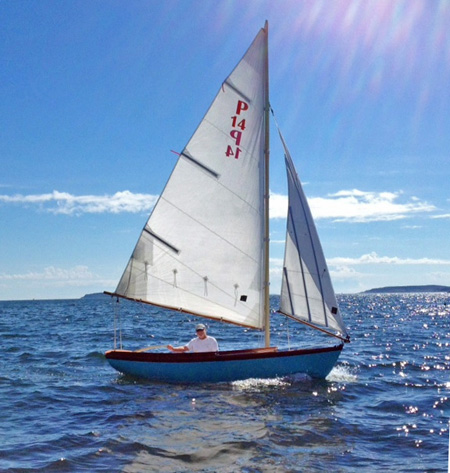
The PAINE DVT at work.
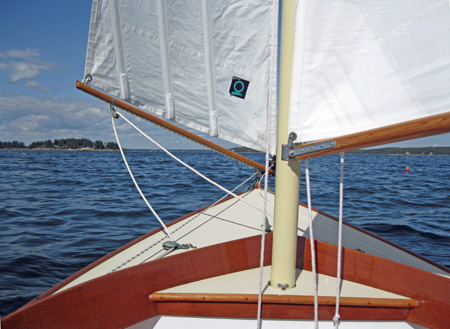
Off the wind, the sail goes OUT, not UP!
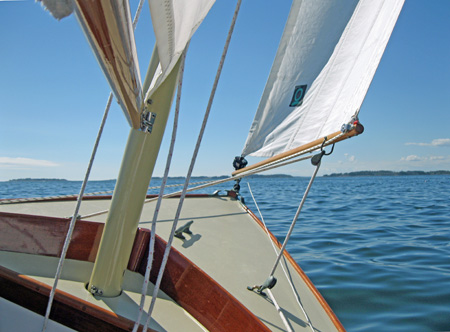
Note that the leech of the jib remains parallel to the luff even though the sheet has been let out
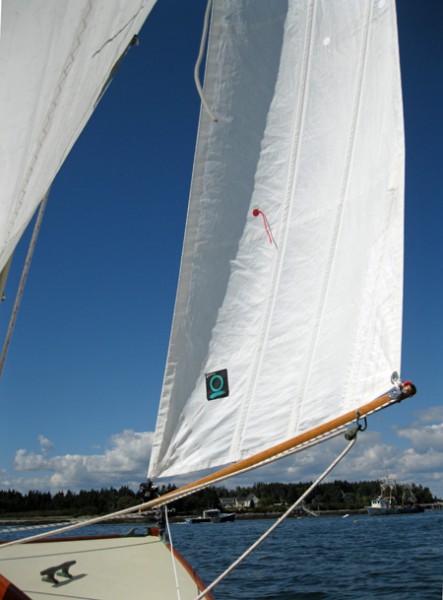
Even let out this much, the angle of the sail to the wind is nearly constant from foot to head.
Make no bones about it, though, inidividually hand-built by the few remaining American craftsmen with nearly half of its weight in cast lead ballast and lots of beautifully varnished (or painted) mahogany trim, this is in every respect, including its construction cost and the need for yearly maintenance, a true yacht of the old school. But you don’t need a mooring or a marina slip with this one, just a garage or boathouse.
MIND THE GAP!
This design has a balanced rudder, making it exquisite to helm. This means that some of the rudder blade area is forward of the pivot axis. This is great for the helm balance, but since the aft end of the boat has deadrise, as soon as the rudder is swung off-center, a gap opens up between the rudder and the hull. It’s like a forward facing pair of scissors.
One week a few summers ago I took my friend Dennis sailing. It was blowing pretty hard, and just as I cast off the mooring a gust caught us on the wrong tack, forcing us to sail over the dinghy painter which was tied to the mooring float. Needless to say, in she went, and almost immediately we were tethered stern to wind, and a lot of it. The forces involved are huge. There was no choice but to wrestle the mainsail down- no small feat― and roll up the jib to remove the pressure. Then fish around underwater with the boom crutch to finally release the jammed rope, near the point of exhaustion. Not exactly a day of elegant relaxation on the water.
Then just to drive the point home we sailed over a lobster pot line an hour later and did the same thing all over again!
I was determined that this would never happen again. I considered the other ways that have been used to mitigate the problem: A windsurfer fin installed just forward of the rudder, or pieces of shock cord that stretch across the open maw- but neither is entirely proof against a jam for as we all know on a sailboat, if anything possibly can go wrong, it will! So I have invented an absolutely jam-proof solution to the problem. Since many other designs have the combination of a balanced rudder and veed hull, I offer my solution for your benefit. It will be fitted to all PAINE 14 s and LEVANT 15 s and YORK 18 s and any similar yachts I might be asked to design in the future.
What I did was to swing the rudder off-center to its maximum possible turning angle. Then I extended the top of the rudder up until it just cleared the hull at this angle. Of course then when you articulate the rudder toward the centerline there is a hull in the way. This I carved away into a section of the surface of a cone, such that the top of the rudder just “sweeps” the concave cone with a paper-width of clearance- far too little for anything to force its way into the gap.
It works great. The amount of turbulence created by the little discontinuity is trivial. And no more embarrassing and potentially dangerous rudder jams!
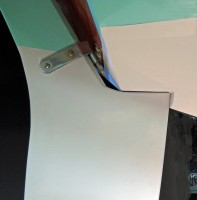
This shows the rudder on centerline.
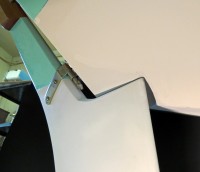
Swung all the way to one side, showing the absence of any gap.
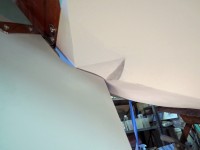
Showing it swung the other way. No way anything larger than a fishing line can get into the gap!
This is the loveliest sailboat you could ever own. It’s hand-built, piece by piece, so only the most cogent sailors can justify owning one. But if you can, it will delight you until your final breath! What the world needs now is certainly not more boats―there’s plenty of clapped-out junk out there―but manifestly far better ones that truly enhance their owners’ lives. You can’t give away old fiberglass boats today, and with good reason. But the few emergent classic sailing designs of obvious and lasting merit are the unique bright spot in boating that makes sense today―the only thing that is selling and rightly so―and the PAINE 14 and its larger sisters the LEVANT 15 and YORK 18 are the most beautiful examples of this emerging phenomenon. We believe the times are right for small, classy, easy to get going and transport, investment quality manageable sized yachts that unlike virtually anything currently available in fiberglass, will be loved for its entire lifetime by its owner and left to his kids and by them to their kids. With reasonable maintenance, they’re built to last that long.
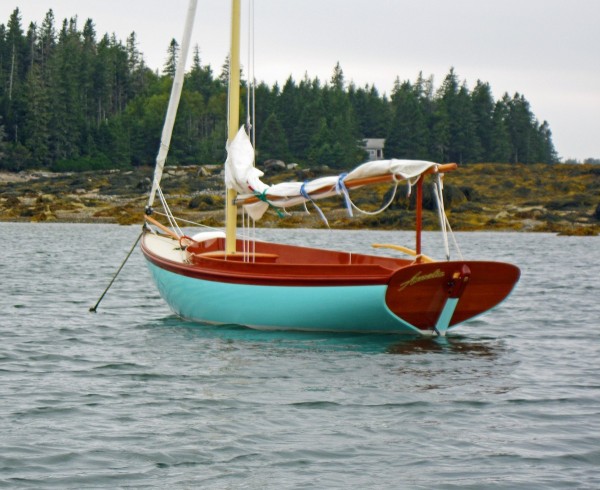
She’s waiting… Whenever you’re ready.
The boating field today is experiencing a wholesale “flight to quality” and flight from consumer-crap. Do we still really believe that a molded fiberglass hull glued to a molded fiberglass deck, with ugly extruded aluminum spars, no varnished wood, and not an ounce of lead to keep it upright, cheap as that may be to produce and sell, is a yacht? An intelligent few of today’s water-lovers are choosing to spend their leisure time in something of intrinsic quality, beauty and unquestionable value. The PAINE 14 and its larger sisters provide the sensible alternatives that truly enhance the lives of those privileged enough to afford time spent aboard her, and their classic design will endure long enough to become a family heirloom.
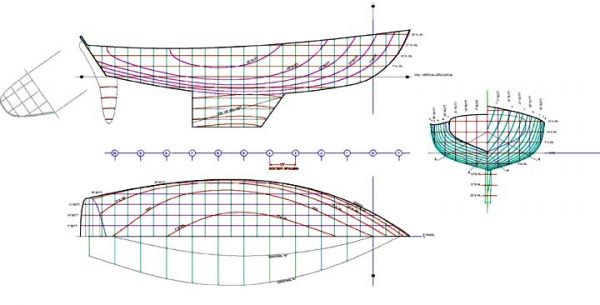
Shallow draft, heavily lead-ballasted, with moderate wetted surface and a NACA-foil laminar flow keel, the PAINE 14 is delightfully fast and easy to handle, store, or trailer to a new destination every summer weekend.
A TRUE MINI-YACHT
In a single phrase, the PAINE 14 is “A TRUE MINI-YACHT.” The yacht is light enough to be easily trailed behind a moderate sized automobile—no truck or SUV or surge brakes are required. The first one, named REDWING , was built in New Zealand. The second one built― AMELIA , was built in America. Both now reside aboard motoryachts.
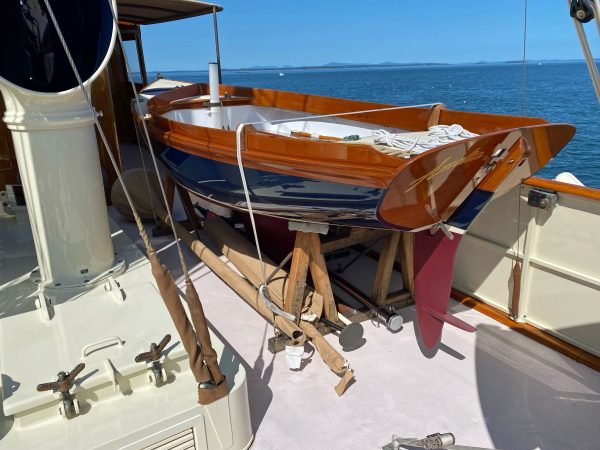
AMELIA aboard her mothership.
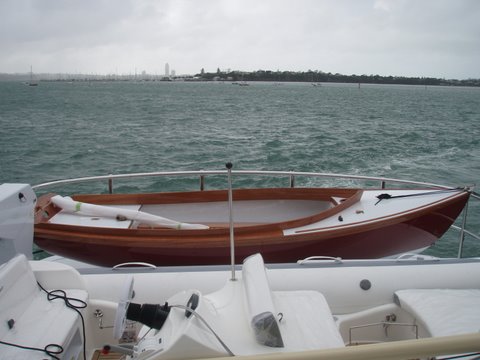
REDWING aboard her mothership.
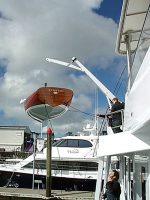
At roughly 850 pounds she is light enough hoist easily with a boat crane.
A custom-fitted galvanized trailer with integral tongue-extender makes launching and retrieving a snap. And at 860 pounds, they can be easily handled by most shipboard boat cranes. The carbon fiber mast requires no stays and is simply swung up into a bronze retainer fitting in a matter of seconds. Unlike a Laser, or any other unballasted dinghy, she is impossible to capsize, and easy to sail mile after mile without athletic ability. You sit “in” her, not “on” her, and there is no need for “hiking out”—you sit on bench seats with properly angled seatbacks (coamings) at just the right height. In enough wind, of course, she could be swamped but has forward and aft flotation tanks to keep her afloat. And in the off-season she fits right into your garage where you can perform the yearly maintenance yourself at near negligible expense, and proudly show her off to your dinner-guests. Or if you lack the time or skills to maintain her yourself, the boatyard fees to keep her in Bristol condition will be so trivial as to make you laugh at the folly of owning anything much bigger.
UNSINKABLE, AND SELF-RESCUING.
Just how safe is a PAINE 14 ? To find out we conducted an intentional swamping to show you. Would she turn turtle, or go to the bottom? Chuck tried to swamp her by standing on the gunwale and leaning out as far as he could, hanging onto the mast. At 180 pounds and rocking the boat violently, the coaming tops could not be gotten close to underwater. Only by bailing the ocean in could he finally swamp her. She floated with the lowest point of the coaming 10 inches above the surrounding water, and was very stable. You could sit in the boat all day long like this and she would not sink. Though like Chuck, you might eventually decide to bail her out, raise the mainsail, and sail away.
You can watch a video of the intentional swamping by clicking here:
Amelia sinking
The performance of the PAINE 14 is, as one might expect from her numbers, downright stimulating. The helm is nicely balanced in both light airs and heavy. Its acceleration in a puff is amazing―in less than a couple of boat lengths it accelerates to hull speed. With the full jib and a reefed main, it can handle 15 to 20 knots of wind. And in stronger winds, she can be sailed under complete control without the jib―an extremely rare capability amongst today’s fleet of small boats. This is also helpful in picking up a mooring or coming alongside a dock or your larger yacht. You can roll up the jib first, clearing the foredeck and its mooring cleat of the nasty slapping jib-boom, and get safely cinched up with a clear field of view.
Those who have read Chuck Paine’s books on yacht design will recall that one of his bugaboos in the latter years of his career was self-rescue. If you fall overboard from even a yacht of low freeboard like this, it is impossible to get back aboard. You can imagine the potential consequences. So Chuck made the decision that no future design of his would lack this important capability. The PAINE 14 is fitted with a simple rescue step on the trailing edge of the rudder. You never know it’s there until you need it. But if you ever do, you’ll thank its designer a thousand times over.
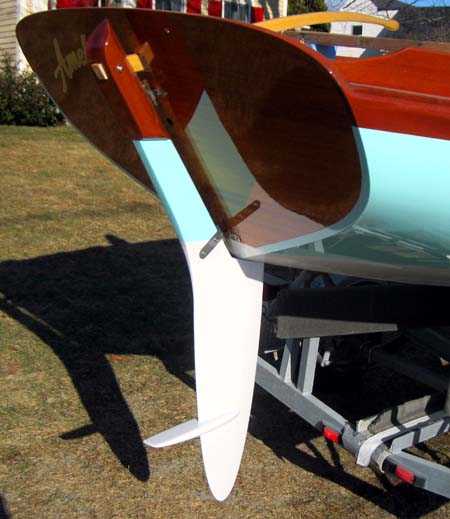
The beautifully crafted rudder with its integral rescue step.
ONE PERFECT POSSESSION
We believe the ethic of filling multiple houses, then rented storage containers with unloved and unused material objects, with all of the environmental damage and unserviceable debt that this might entail, is in precipitous decline. The wiser among us will build their future lives around ONE PERFECT POSSESSION. For those who revel in exploring remote locales without the noise and expense of internal combustion, it’s time accept the reality of the 21 st century, rid yourself of that unused leviathan you can no longer afford nor find crew to operate, and join the renaissance in easily usable sailboats of eternal beauty. Though far from cheap, you can commission a PAINE 14 for what you pay in a few years’ maintenance and storage fees for your unloved and unused thirty-something foot white elephant, and you’ll actually USE your PAINE 14 , as will your progeny!
The yachts are available only in hand-built epoxy consolidated cold-molded wood. In any case the yachts will be beautifully hand-finished with a great deal of painted trim or varnished hardwood to look as beautiful of those from the past century. French & Webb custom boatbuilders in Belfast, Maine, now have the rights to build a sistership for you, at a price of between $80,000 and $90,000 depending upon specification. A custom-designed galvanized trailer with integral tongue extender will enable the yacht to be easily launched on reasonably angled ramps. Its price is US$ 4500.00 plus shipping to your destination from Raleigh, SC. (Prices may change owing to inflation).
Todd French and his crew would gladly enhance your life and that of your progeny by building another for you. D0n’t hesitate― our federal reserve are seemingly unwilling to constrain inflation and the price will surely rise as a result. Better to own and spend a lifetime enjoying a lovely sailing yacht today than have your wealth confiscated tomorrow.
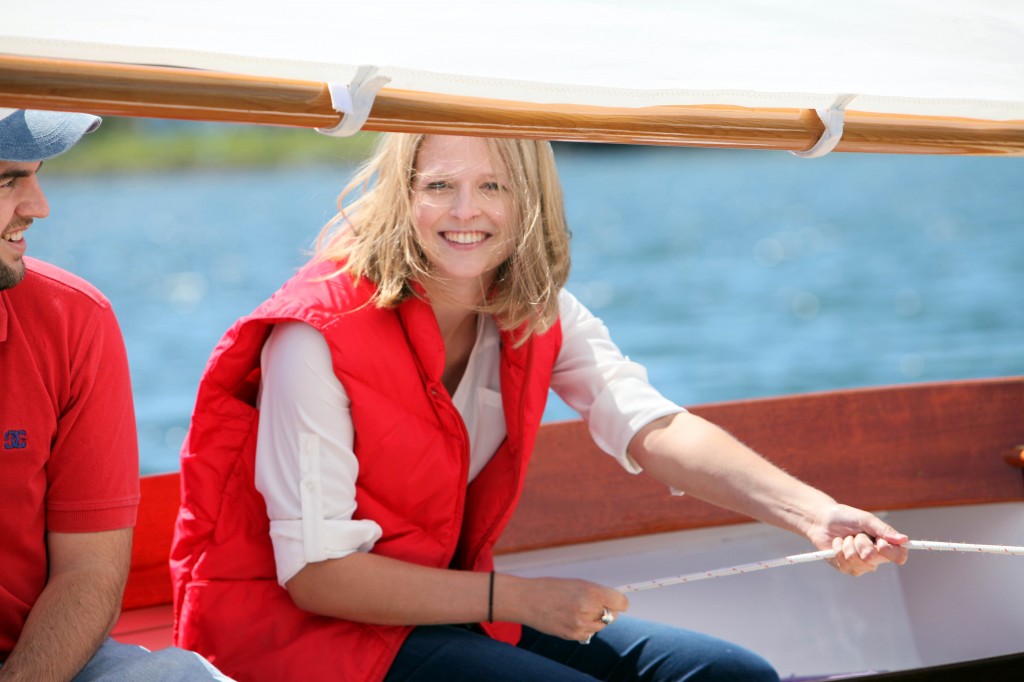
Take her sailing in your PAINE 14 and you’ll make her smile.
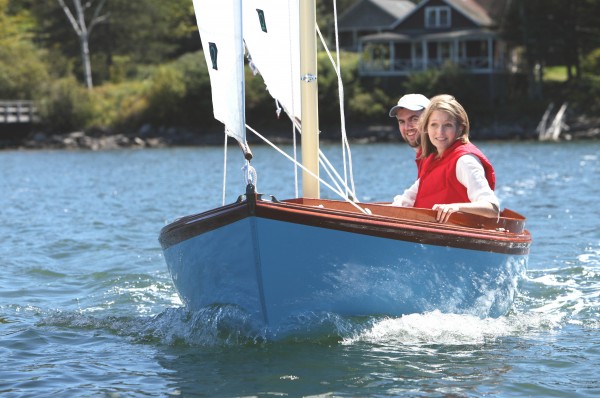
No need for hiking in your PAINE 14 … just showing off.
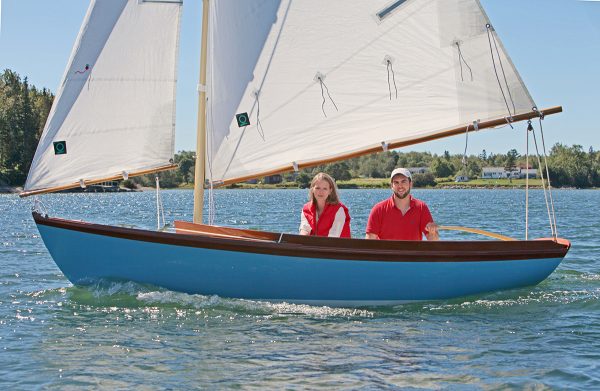
Click here to see what SAIL Magazine had to say:
http://www.sailmagazine.com/best-boats/sails-best-boats-2014-paine-14
Further information may be obtained from:
CHUCKPAINE.COM LLC P.O. Box 114, Tenants Harbor, Maine 04860-0114
Phone: (207) 372-8147
Email: [email protected]
This design is featured in both of my recent books; MY YACHT DESIGNS and the Lessons they taught me, and THE BOATS I’VE LOVED- 20 Classic Sailboat Designs by Chuck Paine. Both are beautiful, full colored, first class books which give you lots more information on this design, and can be purchased on this website.
Click here to read more about the Paine 14
A full set of study plans is available for $25 emailed to you in PDF format.
PDF Study Plans: $25- no shipping, sent via email
Buzzards Bay 14 by L. F. Herreshoff
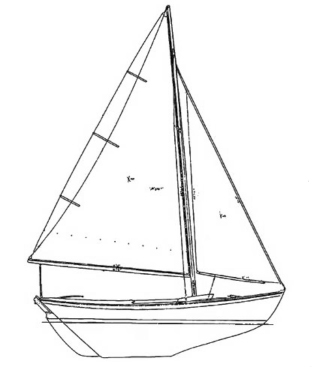
She is a fair amount larger than the 12 ½, with more storage space and increased speed and power. Like the older design, she is an ideal daysailer for deep water coasts, being roomy, comfortable, seaworthy, and good looking. She is specifically designed to contend with the notorious Buzzard’s Bay chop, and thus will be relatively dry and handy under a wide range of conditions on any coast with the water to float her.
While she’ll need a tender to provide shore access for picnics, she is powerful enough to tow one without much bother. Being a “sit down inside” boat, she is very reassuring for timid sailors, and would be excellent for very young yachtsmen and for couples with small children. Like the 12 ½ she does not require a strong or athletic crew, and would be easy to sail singlehanded at all times. A BB14 would be an excellent boat for those getting on in years.
The Herreshoff Catalogue Raisonné
Welcome! For about a hundred years, from the mid-19th to the mid-20th century, boats were built in Bristol, Rhode Island, under the name of Herreshoff. Herreshoff-designed-and-built sailing yachts dominated national and international regattas, and Herreshoff steam yachts were among the world's fastest. With them came worldwide fame and prestige. Nathanael Greene Herreshoff (1848 - 1938), the designer of most of these yachts, is regarded by many as the preeminent yacht designer of that time, if not of all time. His contemporaries called him The Wizard of Bristol , and this became also the title of the first, and still the best, biography of N. G. Herreshoff, first published thirteen years after his death by his son L. Francis Herreshoff, himself a noted yacht designer. We are grateful to have permission to publish the first Internet version of this important book here .
The Herreshoff Catalogue Raisonné at the Herreshoff.info website strives to be the most exhaustive source of information about Herreshoff boats, their models, and their history. Consider it a catalog which documents each and every known boat designed by or built by the Herreshoffs in Bristol — sail boats, steam yachts, military vessels, even rowboats and dinghies. It contains thousands of pages with thousands of vessel images, model photos, and facsimiles of documents. Information is provided about the boats, the half models that were used to create them, construction histories, launching dates, and ownership changes, along with much, much more. The entire catalogue raisonné is thoroughly cross-linked and offers fascinating possibilities for scholars, cognoscenti and owners of Herreshoff-built boats to study and explore N. G. Herreshoff's expansive career and production.
We are extremely fortunate that so much Herreshoff material has survived. Of some 2,000 craft built by the Herreshoffs, for example, more than 400 are still with us, owned privately and by at least eight museums. The Herreshoff Marine Museum in Bristol, Rhode Island has an unmatched collection of Herreshoff boats, yachts, and artifacts. It also houses one of the world's outstanding collections of half models made by several generations of the Herreshoff family including almost every half model ever carved by Nathanael Greene Herreshoff himself over his 75-year career as a designer. A visit to the Herreshoff Museum's model room is like stepping into an art museum and seeing every work of art ever created by a single famous artist — every one! (It is also what has caused this catalog to be named a catalogue raisonné.) Then there is the massive collection of Herreshoff drawings and related artifacts in the Hart Nautical Collection at the MIT Museum in Cambridge, Massachusetts. Mystic Seaport Museum in Mystic, Connecticut, holds large image collections (including photos by Burton, Bolles, and Rosenfeld) containing Herreshoff watercraft, as well as plans and artifacts (including hundreds of casting patterns), and a number of small boats built by HMCo. The Mariners Museum in Newport News, Virginia, has many photos of Herreshoff boats (by Levick and others) and at least two Herreshoff boats in its collection. Although entire books have been written about the Herreshoffs as well as newspaper and magazine articles, never before has an attempt been made to document all Herreshoff boats and models by systematically drawing on information from all these sources in order to create a larger whole. This is what the Herreshoff Catalogue Raisonné is all about. Freely-accessible and continually reviewed and expanded, it is an ongoing endeavor intended to enable an understanding never before possible.
The pages that follow are dedicated to the Herreshoff Manufacturing Company and the Herreshoffs of Bristol.


Search form

The Paine 14
A modern, more manageable take on the herreshoff 12½..
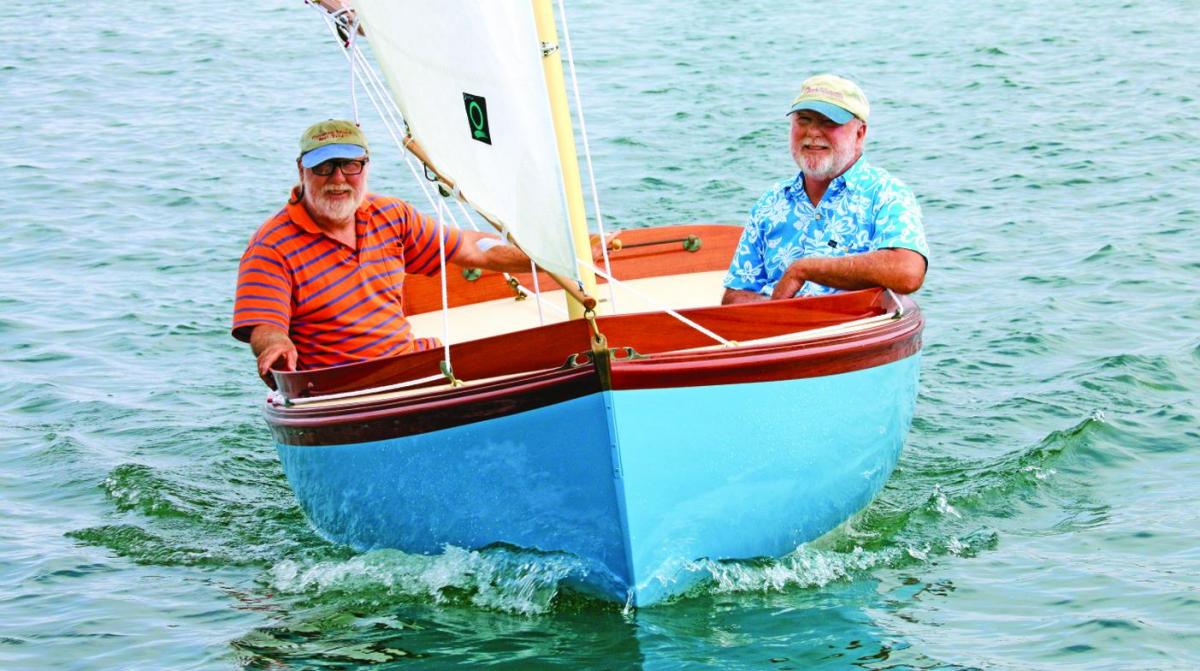
There are folks in this world who from an early age not only dream, but do. This is a story about one such person: my identical twin brother, Chuck Paine, and his project designing and building a modified cold-molded Herreshoff 12 ½.
The boat, named Amelia and painted a glossy light blue, was launched last summer and introduced to the world at the 2013 Maine Boats Homes & Harbors Show. At press time, Chuck already had taken an order for one and was working with a builder to produce more.
Chuck and I grew up on Jamestown Island near Newport, Rhode Island. We spent our summers surrounded by boats—ferries, Navy ships, rowboats, and yachts. We hung around boatyards, but as our mother decreed, kept quiet, were polite, and distracted nobody at their work.
The two biggest shipyards were Wharton’s and the Round House. Wharton’s built everything from sawn-frame fishing trawlers to exquisite pulling boats. The Round House sheds, to the best of my recollection, handled little other than power and sailing yachts designed and built by the Herreshoff brothers.
To say that Chuck and I were enthralled with the beauty and performance of these gorgeous yachts would be an understatement. As soon as we could read, we devoured Rudder, Skipper, Motor Boating, and especially the design section of Yachting. Soon enough we found the two or three books dedicated to the Herreshoff family, concentrating on John B. and Nathanael G. Herreshoff. Much to my mother’s concern, we were one-track nautical fanatics. All we wanted in life was to follow in the path of Nat Herreshoff. (It is not an accident that I named my only son Nathaniel.)
Chuck and I committed the Herreshoff scantling rules to memory. We learned to fair lines before our teens, and took private (and free) drafting lessons from Charles F. “Chick” Street, a talented amateur yacht designer and a Massachusetts Institute of Technology naval architecture graduate.
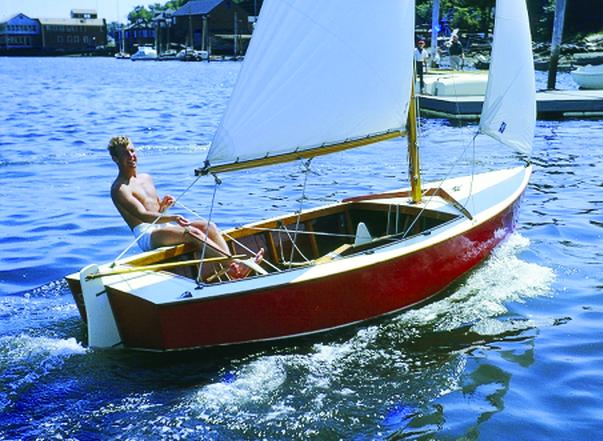
To our immense good fortune, Chuck and I were artistic prodigies, a fact not lost upon the state of Rhode Island. As “gifted and talented” teens, we were selected to attend subsidized art classes at Rhode Island School of Design in Providence. Another subsidized program allowed us, at age 13, to take sailing lessons in what was our first time in a sailboat. We soon were winning more than our share of races on Narragansett Bay, perhaps through some sort of inbred talent but more likely due to the unfair advantage of twin telepathy and exactly equal weight.
Eventually our love of boats boiled over. We saved our earnings from paper routes, lawn-mowing, and other jobs to build our own racing boat, a Bluejay, which was the youth boat of choice then. Despite having no experience and only a few hand tools, we purchased a set of plans from Sparkman and Stephens for $50, which included our official racing number. Too young to drive, we traveled by bus to the M. L. Condon Company in White Plains, New York, where we hand-selected our expensive Sitka spruce, mahogany, and Bruynzeel marine plywood. Long story short, two 14-year-old kids built a Bluejay named Scratch that became nearly unbeatable on Narragansett Bay. Two years later, we sailed Scratch to second place in the North American championships.
I had pluck and could draw, but on top of sharing those assets Chuck was smart and did well in school. He sailed through the upper tracks of elementary and high school, concentrating upon the tough classes like math and science, always with an eye toward engineering. After all, the Herreshoffs made the top of the heap as much through mechanics as through art. Chuck’s mental magic hit the jackpot when he took the College Boards. He missed getting a perfect combined score of 1600 by getting a single math question wrong. He went to Brown University and studied mechanical engineering, enabled by plentiful financial aid and a state scholarship.
As is well known now in the yacht-design world, Chuck never lost his eye for the prize—to follow in the footsteps of Nat Herreshoff. After years of unswerving effort he established his own design firm, and more than 1,000 boats have been launched to his designs.
In 1971, at the age of 27, Chuck bought a wooden Herreshoff 12½, which he renamed Petunia . He proceeded to restore it to near-new condition and steered the boat for many a happy mile. When he retired from Paine Yacht Design four years ago, he wrote a book about his designs and the philosophy behind his oeuvre and the boating business. Then he undertook a project about which he’d long dreamed: he attempted to improve the one boat design he’d considered virtually unmatched.
Chuck has often said that the 12½ represents Nathanael Herreshoff’s absolute best design. Others say it’s the most satisfying boat to own in the watery world. In my opinion, few keelboats of any size can boast such a comfortable cockpit, and the 12 ½ is almost impossible to capsize.
But owning one of these jewels is a commitment. Built originally to meet a budget, not for longevity, they require constant maintenance.
Chuck’s goal was to create a boat that looked almost identical to Petunia , but he wanted to make it smaller, for easier trailering, and to add small conveniences to make setup quicker and maintenance less. He also wanted to reduce the wetted surface by nearly half to make the boat faster.
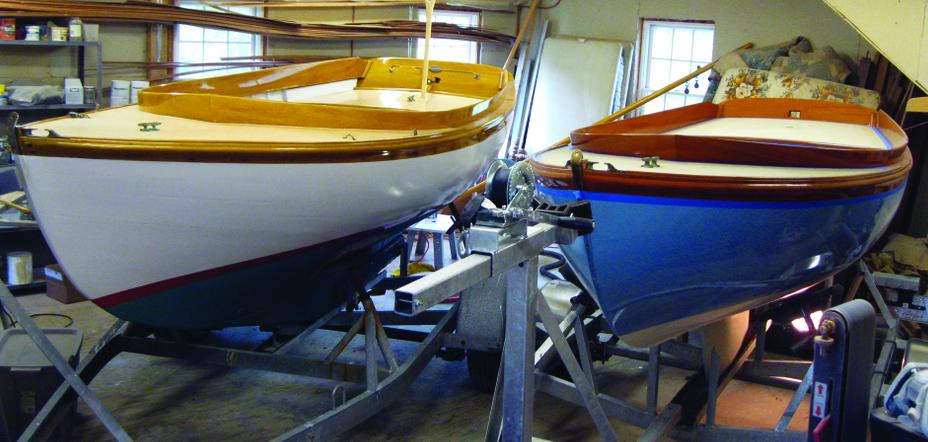
Herreshoff was never asked to put these features into the 12½ in 1913, when he was commissioned to design a boat for youngsters learning to sail on Buzzards Bay. Maybe left to his own devices he might have tried the split underbody— such fins were being experimented with at the time on skimming-dish sail racers. Petunia , and fiberglass versions, such as the Doughdish and the Cape Cod Shipbuilding H-12, do have wonderful qualities. They’re pretty and especially comfortable due to a commodious cockpit. Small sailboats, especially ones meant to be trailered, normally have a centerboard. But while centerboarders can flip, keelboats do so only rarely. That is yet another advantage of the 12½, especially as a craft for the young and the old.
The Paine 14 is as identical as Chuck could make it to the12 ½. Down to the finest details—the covering boards and coamings, the bow and stern flotation tanks, even the fittings and paint scheme are very similar. The molded sheer strakes were specially constructed on the property of the Herreshoff Marine Museum in Bristol, Rhode Island.
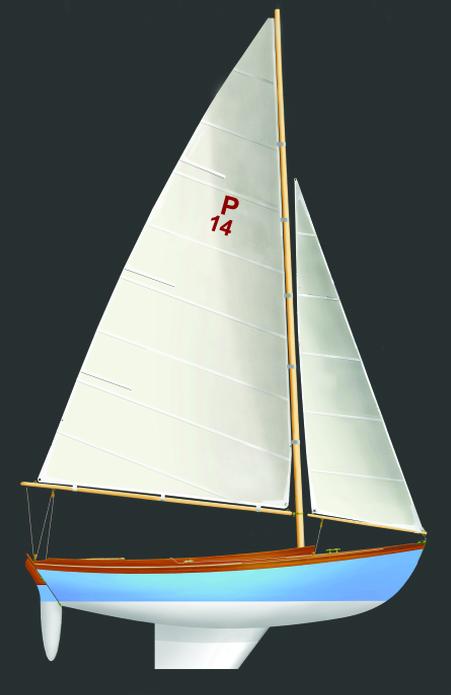
Like most yacht designers, Chuck spent his career drafting plans that were influenced by the stipulations of clients and corporations. But designers of all stripes can be their most visionary when not held in harness by clients.
“It was tremendous fun designing a boat without someone else telling me what to do,” said Chuck. I think it’s partly for this reason that Chuck, not normally a big risk-taker, pulled out all the stops in terms of inventiveness.
I can hear you thinking, “In such a small boat and one which intentionally mimics something already in existence, how much improvement can be expected?” It was reasonable to expect evolutionary, but not revolutionary results.
But when I went down to Tenants Harbor on launching day at the end of July to “test-drive” the boat, I found it to be a scintillating performer. When I say performance, I mean that in two respects. Amelia sails faster and is much easier to maneuver than a Herreshoff 12 ½, and is more manageable.
The Paine 14 can be stored on a trailer in a garage and towed easily behind a normal-sized car, in part because it weighs about half as much as the Herreshoff version. It draws slightly less, and thus can be launched at any normal ramp from the extendable-boom Triad trailer. The carbon fiber mast does not require stays and is easily stepped (which was more important to Chuck than a light mast’s effect upon stability and speed). The sails are easy to rig, because the jib luff contains the forestay—a pull on its halyard is all that’s needed. The main has no track or slides; rather it is bent to the mast with five Velcro straps.
When I sailed Amelia , I was blindsided by the way the boat accelerated. In eight knots of breeze or more, the boat went from dead in the water to full speed in three or four boat lengths, as long as the sails were trimmed right. The teeny little rudder—a perfect airfoil—was capable of whirling the boat in pirouettes.
In a journalist’s necessary inclination toward full disclosure, here are some revelations: Amelia was not Chuck’s first attempt toward a modern version of a 12½. Just prior to his “retirement,” he drew a nearly identical hull for a client who wanted a small daysailer to stow aboard his Paine-designed motoryacht. That boat, which was built in New Zealand, was gaff-rigged, with small differences in keel size and placement. Also, Joel White designed a trailerable wooden boat called the Haven 12 ½, which deserves consideration as a shoal-draft variant that’s the same size as the original Herreshoffs.
None of these boats can or will ever be inexpensive. A cold-molded version of the P-14 will cost $70,000 and a fiberglass P-14 carries a projected price of $39,000 or so.
Is there a market for even the prettiest copy of a Herreshoff 12 ½? If so, from what quarter? There are and will always be people who’ll seek out sisterships of Petunia , willing to pay a high price for any boat that is restorable, providing it has a Herreshoff Manufacturing Co. builder’s plaque.
But Amelia looks just as lovely, and will be far easier to own. After testing Chuck’s amazing best-ever design, I predict that the design will sell like French fries at a county fair.
Art Paine is a boat designer, fine artist, freelance writer, aesthete, and photographer who lives in Bernard, Maine.
Herreshoff 12 ½ vs. Paine 14:
The Numbers
“The boats are very different in some ways, intentionally very similar in others because, as I will always profess, the H12½ is the best yacht design ever done by anyone. The big difference is that the P-14 is significantly lighter. I am amazed by the effect that this has upon the boat’s performance.” — Chuck Paine
LOA: 15'10" LOA: 14'
LWL: 12'6" LWL: 11'3"
Beam: 5'10" Beam: 5'4"
Draft: 2'6" Draft: 2'3"
Displ: 1,500 lbs. Displ: 860 lbs.
Designer/Builder:
ChuckPaine.com, LLC, P.O. Box 114, Tenants Harbor, ME 04860, www.chuckpaine.com
Related Articles
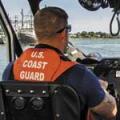
Share this article:

Digital Edition Available ×
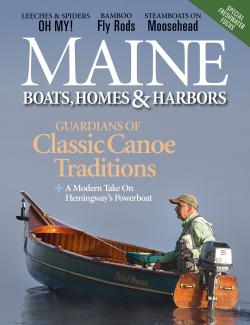
Can't get to the store to buy your magazine? We deliver the stories of Maine's coast right to your inbox. Sign up here for a digital edition .
2023 Maine Boat & Home Show ×

Join Us for the Maine Boat & Home Show !
Art, Artisans, Food, Fun & Boats, Boats, Boats
August 11 - 13, 2023 | On the waterfront, Rockland, Maine
Click here to pre-order your tickets.
Show is produced by Maine Boats, Homes & Harbors magazine.
Closed for the Winter Season | Donate to the Museum

February 18, 2021
Introducing “The Herreshoff Brothers and their Torpedo Boats”
A series of papers on bringing innovation to the "New Navy"
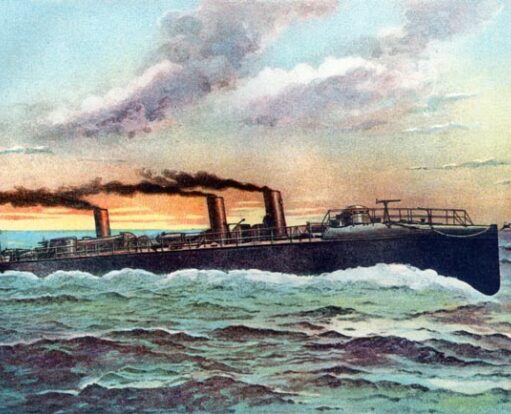
Recognition
On December 21, 1896 the Naval Torpedo Station honored Capt. Nat Herreshoff by inviting him to Newport for maneuvers and a photoshoot of three generations of Herreshoff torpedo boats. From left to right in the above photo, Capt. Nat arrived aboard his latest design PORTER (TB-6) , just her second day underway after launching and installation of machinery. He is joined by the 1887 STILETTO (WTB-1) and the Navy’s first sea-going torpedo boat the 1890 CUSHING (TB-1) . It was a well-deserved recognition, because it was upon the first two Herreshoff hulls that the Navy developed a basic torpedo warfare capability- a weapon and the vehicle to deliver it. [1]
This is the story of the Herreshoff brothers experience in introducing new technology into the competitive U.S. Navy torpedo boat market. It is developed from the latest information available from research of Herreshoff family papers, the records of the Herreshoff Manufacturing Co. (HMCo.) and the Navy, personal papers and biographies of the important individuals, and newspaper archives. The story is told primarily in a chronological series of papers, each centered on a specific torpedo boat, built or proposed for the U.S. Navy over a period of 22 years from 1875-1897. Each story places the vessel in the environment of the day. Because the events of 1860 and the Civil War to follow were so transformative for the Herreshoff brothers and especially the U.S. Navy that is where the story begins. On the back end the Postscript extends to U.S. Navy plans for destroyers in 1904.
The papers in the series are:
1. The Players- 1860 2. War and its Aftermath 3. LIGHTNING: A Win for the Herreshoff System 4. Preparing for STILETTO 5. HMCo. #118 STILETTO and the Torpedo Cruiser, 1883-1885. 6. Herreshoff Success: US Navy Purchase of STILETTO, 1886-1895 7. Admiral Porter & Herreshoff: Surprising End to the Torpedo Cruiser Story 8. US Navy's First Sea-Going Torpedo Boat CUSHING; Herreshoff Success & Frustration 9. Herreshoff Failed Bids and Frustration: Torpedo Boats 2, 3, 4 & 5 | 1890-1895 10. Success: Torpedo Boats 6 & 7 | 1895-1897 11. Coming Soon: Part XI begins in FY 1897 with the disastrous failure of Herreshoff to win a contract for a 30-knot TB. The success of TBs 14, 15 & 16; models of economy of construction and operation. The subsequent Herreshoff bidding failure and departure from the torpedo boat business. 12. The Postscript will address questions and comments received through the series.
Above all, these papers are a search for the facts. An attempt to satisfy the caution Capt. Nat expressed in a letter to W. P. Stephens, “Do not you think it is better… not to make statements until you know the facts?”[2]
When I started as a volunteer in 1997 the torpedo boat “facts” told to visitors were: While today HMCo. is remembered for America’s Cup victories, great racing schooners, and successful racing and cruising one-designs, from 1868-1897 Herreshoff built 180 steam vessels, twice the number of sail; 70% of the these were high-speed launches and yachts; 30% were vessels for government service, and eight of those were torpedo boats for the U.S. Navy. New technology was developed in the private sector and then applied to Navy work. Herreshoff built the first U.S. Navy torpedo boat, USS LIGHTNING . Herreshoff torpedo boats were the best; each new design providing better performance and speed. Herreshoff chafed under the direction of local Navy inspectors, who they saw as interfering and less competent than themselves. This came to a head with an incident on USS DUPONT (TB-7). Herreshoff was directed by inspectors to change the material for an engine slide resulting in a failure during trials. That was the last straw and they precipitously left Navy work. Who needed that grief when they had America’s Cup boats to build for customers who accepted their designs without question and paid what was asked?
However, research has proven this narrative to be overly simplistic and plain wrong on a number of counts. To cite just two: it is problematic to claim Herreshoff built the first torpedo boat, and the primary Navy inspector throughout the building of all the torpedo boats was a collaborator and supporter who risked his career in that effort. Additionally, like some other HMCo. stories it is presented as if the company existed in a vacuum devoid of a complex customer, competitors, and other outside forces, institutions and personalities. This series of papers aims to take these factors into account alongside a more thorough examination and analysis of the historical record. The papers will be published at intervals throughout the remainder of 2021.
Acknowledgments
Much has been learned since 1997 and we have many people to thank for the progress.
In 2001 the late Bristol historian Richard Simpson published Building the Mosquito Fleet: The U.S. Navy’s First Torpedo Boats and followed up in 2016 with Goat Island and the U.S. Naval Torpedo Station: Gun Cotton, Smokeless Powder and Torpedoes. These contained new information on the Herreshoff torpedo boats that he was wise enough to rescue from the trash heap during changing administrations and downsizing of the Newport Torpedo Station. A good friend, he donated much of his archive to the Museum.
New research by the Museum supported an updated torpedo boat story for the 2002 exhibit, In Defense of the Nation: The Herreshoff Story 1875 to 1945 . In 2007 the late David W. McComb, author and lecturer on the history of U.S. Navy destroyers and enthusiastic founder of the Destroyer History Foundation ( www.destroyerhistory.org .), collaborated with us to achieve an understanding of the nexus between the Herreshoff torpedo boats and the U.S. Navy’s first destroyers- a larger type known as the “torpedo boat destroyer”. Dave was the first to postulate the importance of the “Narragansett Bay Connection” (Newport Naval Torpedo Station founded 1869, John Brown Herreshoff first with steam vessels in 1868 and continuing with HMCo. founded 1878, and the Naval War College founded 1884).
Dave was also the first to highlight the importance of George Albert Converse, who was the Navy representative at HMCo. throughout the torpedo boat years. Both Dave and I separately researched the Converse Collection preserved at the DeGolyer Library, Southern Methodist University. (Who would have thought the answers to many Herreshoff torpedo boat questions resided in Dallas, TX?) Fortunately, the Library, with encouragement from John Hattendorf, former E.J. King Professor of Naval History, Naval War College, has placed much of the Converse material online.
The majority of the Nathanael G. Herreshoff Collection housed in the museum has received at least a preliminary inventory and is safely preserved in archival boxes. Our major collection of Capt. Nat’s letters was rescued from a large Tupperware box found in Museum storage and is now carefully preserved and cataloged. Donors have contributed important materials; the PORTER/DUPONT construction contracts come from Capt. Richard Hamly USN (Ret) and the proposed Edward Burgess/Nat Herreshoff cooperation to design the first sea-going torpedo boat from Burgess family papers. The 1986 bequest of Louise DeWolf, John Brown Herreshoff’s granddaughter, included original HMCo. materials as well as an extensive collection of Herreshoff Family letters and papers. The Museum’s Archives contains these manuscript collections and additional collections related to HMCo., the Herreshoff Family and the America’s Cup. They are preserved and cataloged. Thanks to the work of Norene Rickson and Evelyn Ansel and their volunteers progress continues to be made on the collection each and every day. The loose papers filling the drawers of the Model Room drawing table and many handwritten design notes by Capt. Nat have been scanned and prepared for indexing. Halsey Herreshoff provided access to Capt. Nat’s diaries and Naval Architecture and Engineering Notes for the torpedo boats, and the open-water model testing of their hull designs. Further he commissioned his alma mater Webb Institute to conduct a modern test and analysis of Capt. Nat’s PORTER/DUPONTmodel.
More knowledge came from the Museum’s new Steam exhibit generously funded by the Van Beuren Charitable Foundation and the Norman Foundation. Bill Lynn, Mike Rossi, Dave Spencer and Sandy Lee did the research and exhibit development and Evelyn Ansel led the installation.
Sandy Lee volunteered the journals and materials of RADM Tattnall Nichols; first-hand accounts of the U.S. Navy during the doldrums following the Civil War. Sandy’s RELIANCE modeland Steam Launch HMCo. 199 Projects have led to a better understanding of what HMCo., its foremen and craftsmen did, and how they did it.
Kurt Hasselbalch, former Curator Hart Nautical Collections MIT Museum, produced Lighter, Stronger, Faster: The Herreshoff Legacy Exhibit and oversaw the digitization of the HMCo. plans collection, previously loaned and then donated to MIT by Rudolph Haffenreffer.
Claas van der Linde, Herreshoff researcher extraordinaire, has put it all together with the Herreshoff Catalogue Raisonnè : the place to start any research into things Herreshoff.
And on the Navy side of things, the Hathiway Trust has made available online the Annual Reports of the Secretary of the Navy. These documents not only include the Secretary’s report but the reports to him from the Navy Bureaus; the latter often including reports from subordinate Navy commands such as U.S. Naval Torpedo Station Newport.
[1] Nathanael G. Herreshoff diary entry Dec 21, 1896. Diary access courtesy Halsey C. Herreshoff. PORTER shows a high freeboard because she is not fully outfitted nor loaded with stores and consumables.
[2] John W. Streeter (annotated). Nathanael Greene Herreshoff, William Piccard Stephens: Their Last Letters 1930-1938 (Bristol, RI: Herreshoff Marine Museum, 1988). Letter #3 NGH to WPS, June 12, 1930, pg. 19.
Great choice! Your favorites are temporarily saved for this session. Sign in to save them permanently, access them on any device, and receive relevant alerts.
- Sailboat Guide
Herreshoff Mfg. Co.
Formed as a partnership between John Brown Herreshoff and his younger brother, Nathaniel. Though the reputation of the latter is well established, it was the elder Herreshoff (who was blind), that kept the finances in order. So important was his role that company was sold very shortly after his death. The Herreshoff Museum has a website, listed below. A visit to the museum is certainly worth the trip even for the casual enthusiast. Others might find themselves looking for longer term accommodations. Over 14,000 plans and related design records were loaned to MIT when the firm was closed by the General Manager, Rudolph F. Haffenreffer (MIT Class of 1895). In 1961, the Haffenreffer Family donated the collection to MIT. A 218 page guide is available at MIT Museum or by mail from the Hart curator. web.mit.edu herreshoff-legacy.mit.edu
Associations
- Bullseye Class Association
- Herreshoff Legacy: An MIT Museum Project
- The Herreshoff Registry
- Herreshoff Marine Museum
- bronzeblocks.com
- A. Sidney DeWolf Herreshoff
- George Owen
- Nathaniel G. Herreshoff
27 sailboats built by Herreshoff Mfg. Co.

Herreshoff 12 1/2

Herreshoff Marlin 23

Cape Cod Gemini

Herreshoff S-Class

Buzzards Bay 15

Herreshoff Fish

New York Yacht Club 30

Fishers Island 31

Fishers Island 23
New york yacht club 40, buzzards bay 30, bar harbor 31.

Biscayne Bay 14
New york yacht club 50, buzzards bay 25, herreshoff newport 29, buzzards bay 18.

Herreshoff Marlin
New york yacht club 70, new york yacht club 57, watch hill 15.

Tech Dinghy

Herreshoff Seawanhaka One-Design

Herreshoff Seafarer

Herreshoff 15

- About Sailboat Guide
©2024 Sea Time Tech, LLC
This site is protected by reCAPTCHA and the Google Privacy Policy and Terms of Service apply.
Series Small Boats Annual 2007
The Flatfish
An inspired daysailer
From Issue Small Boats Annual 2007
E very sailor has his own vision of the perfect daysailer. For many, this ideal boat is based on the Herreshoff 12 1⁄2, Nathanael G. Herreshoff’s iconic daysailer, which debuted in the summer of 1915. For others, it’s the larger Fish class or the still-larger Alerion—two more masterworks from the hand of Herreshoff. These boats have been the subject of imitation and interpretation ever since they hit the water over 100 years ago. The Flatfish, designed in the early 1990s, is Joel White’s version of Herreshoff’s Fish.
In 1992, I was looking for a boat to build for my parents, then in their late 60s. They weren’t going cruising anymore, so I was looking for their perfect daysailer. The boat had to be big enough so that they wouldn’t get physically knocked around, and it had to be trailerable. My folks wanted something they could sail on the Hudson and take to both Maine and the Chesapeake. As with any daysailer, the destination becomes less important while the experience of sailing grows. In other words, she had to look good and perform well.
Picking a boat is always a balance of beauty, performance, cost, and, in this case, opportunity. A conversation with Maynard Bray, WoodenBoat magazine’s technical editor, led to an offer to build the first Flatfish, a design project he was working on with Joel White. It was an offer I couldn’t refuse. The boat sounded perfect for my parents’ requirements, and I thought I could build it in a year of half-time work.
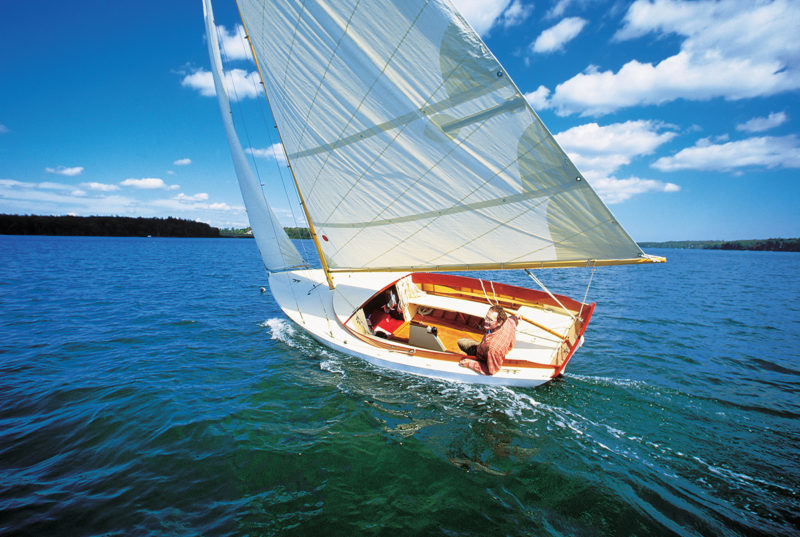
Flatfish is Joel White’s adaptation of Nathanael G. Herreshoff’s century-old Fish-class sloop. The Fish class is a keelboat; the principal modification in the Flatfish is the addition of a centerboard—and the subtraction of some draft. The boat pictured above and on the opposite page was built by Chip Flanagan of Portland, Maine, who’s at the helm.
When I first spoke with him, Joel had just done the initial drawings. Joel’s objective was to make the Fish trailerable, while retaining all the wonderful qualities of the original. Designed toward the end of Joel’s career, the Flatfish incorporates his experience as a leading builder and designer, and “does no harm” to Herreshoff’s design. The result is a boat with elegant looks. Every curve is right. A few inches over 20′ long, she’s big enough to sail comfortably with six people, but small enough to be easily singlehanded. With a gaff main and a club jib, her simple sloop rig tacks with one move of the tiller and the change of a running backstay. The hull is heavy enough to stand up to a stiff breeze or to carry its way through flat spots and shoot directly into the wind up to a mooring. It’s also slippery enough to accelerate quickly and outpace most boats under 30′, and with the cockpit close to the water there’s a real feeling of speed.
The Flatfish is Joel White’s second direct interpretation of N.G. Herreshoff’s classic hull shape. The first, the Haven 12 1⁄2, has been built by hundreds of professional and amateur builders—my shop included. Shallower and broader than Herreshoff’s originals, both of White’s designs use a keel-centerboard arrangement to maintain performance while making the boats trailerable. There are differences between the Haven and the Flatfish, especially in accommodations, building time, and hull speed. The larger boat comfortably accommodates two more people, and the cuddy cabin allows for stowage and the possibility of a porta-potti. In use, the dockage and launching fees for the Flatfish will be higher. She’s trailerable, but not easily launched at a ramp. She really needs a lift to launch and some mechanical advantage to step the mast. Once rigged, both boats require the same work to get underway.
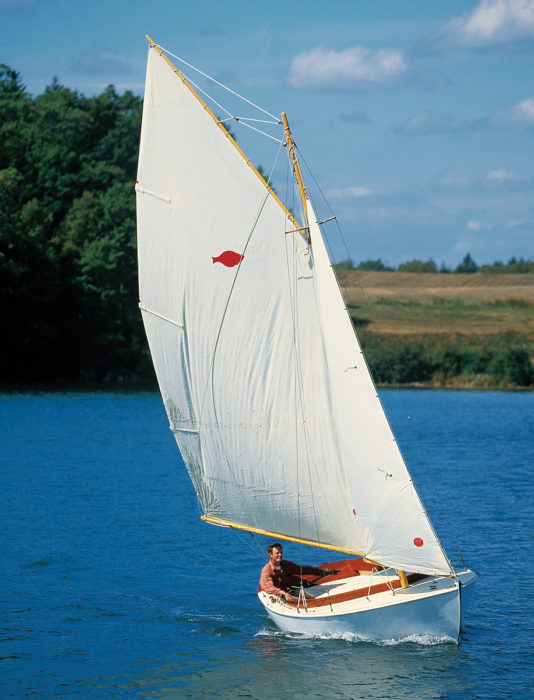
The building process of the two boats is almost identical and is well documented in Maynard Bray’s book Building the Haven 12 1⁄2. That said, the Flatfish is a lot more boat to build than the Haven. There’s more of everything— building molds, planks, frames, deckbeams. There’s also the cuddy cabin. Comparing the displacement of the hulls minus the ballast, one of White’s own cost-estimating techniques, provides a good indicator of the relative work involved in building the two boats. The Flatfish weighs 1,300 lbs compared to the Haven’s 800 lbs—a factor of 1.625. I found this ratio to be even a little low when applying it to building hours. The time required to build a Flatfish is closer to double that for a Haven, probably because the shorter boat can utilize more one-piece planks and smaller stock. Both the Haven and the Flatfish are designed to be built using the Herreshoff method, which involves one mold for each steamed frame. It’s a lot of work for a single boat, but it makes for a very fair hull and certainly works well for a production boat. It also makes a boat that lasts. There are many hundred-year-old Herreshoffs still sailing. This boat requires 22 molds for the Herreshoff method, while it probably take less than half that number for a conventionally planked carvel hull.
On the water the Haven is evenly matched with its sibling Herreshoff 12 1⁄2. Joel wasn’t able to achieve the same parity with the larger boats. The Flatfish is slightly faster than the Fish. We proved this by match-racing my folks’ Flatfish with an original Fish. Both had new sails and the better helmsman was in the Fish, yet the Flatfish just slightly outpaced the original. (I think the centerboard is the culprit, providing better windward ability.) The profiles of the boats are very similar; there’s a slight difference in the run aft. The real difference is the Flatfish’s broader beam. It’s especially noticeable when the two boats are side by side, on shore or in the water.
Another design goal was to make the boat trailerable for easy transport and storage. My parents’ boat has logged several thousand miles on its trailer. The hull seems no worse for the wear. She also has spent every winter stored in the backyard under a temporary garage. Having her at home allows for convenient maintenance and really makes the boat a part of the family.
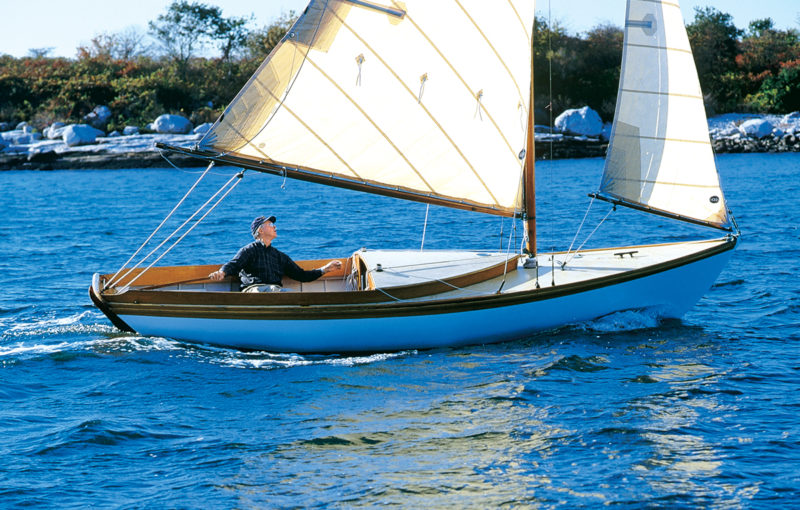
An original Herreshoff Fish, SHARK, near Noank, Connnecticut. The Fish is narrower and deeper than the Flatfish; the greater beam of the Flatfish compensates for the reduced stability caused by the newer design’s shallower keel.
The boat sails wonderfully well with its gaff rig. She points well, has real power on anything close to a reach, and has low heeling moment. White also drew a marconi rig, but I have no experience with it.
Almost ten years of sailing has exposed only one design flaw: We haven’t found a good way to add an outboard or other auxiliary power, aside from an oar. The transom rake is the main culprit. Electric motors can accommodate the rake, but they lack enough power to punch the boat into a real breeze. Side-mount brackets allow for a gas motor, but the motor swamps when the boat rolls. The stern-mount bracket used on the fiberglass 12 1⁄2 s built by Cape Cod Shipbuilding also tends to dunk the motor in any sort of sea. With all solutions, the motor needs to be removed for sailing and stored in the boat; otherwise, it fouls the mainsheets. Cutting an outboard well into the bottom planking has also been tried, but it’s very intrusive and it slows the boat. The best solution is just to sail off a mooring, plan well, and pay attention to wind and tide.
With the Flatfish design, Joel White followed the engineer’s maxim of not putting one extra piece of wood in the boat, and the designer’s rule of not placing one extra line on the drawing. The design does everything it’s supposed to do: It provides a sweet-lined, capable, transportable boat.
I’d certainly like to live in a house on a rock-lined coast with my boat on a mooring that I can see from my back window. I don’t. This boat’s combination of trailerability, good sailing qualities, and classic elegance (along with rental cottages) makes that world accessible. It’s a wonderful boat to sail off a mooring on the morning’s outgoing tide, take a picnic lunch, and catch the incoming tide as the breeze dies at the end of the day.
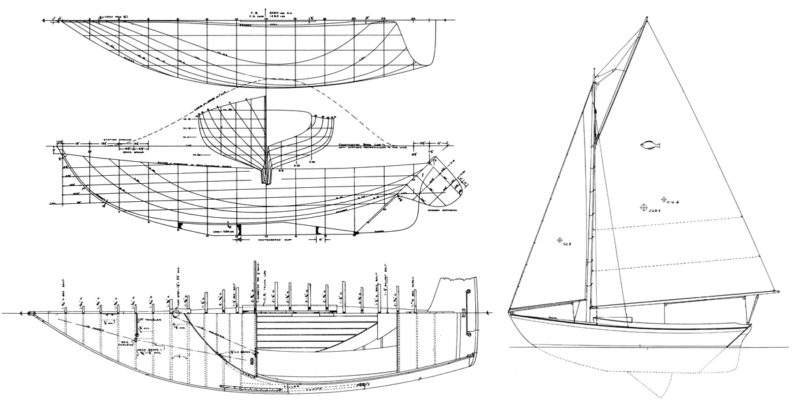
Aficionados of the Herrehsoff 12 1⁄2 and the Haven 12 1⁄2 will recognize these boats in the Flatfish’s lines and sailplan (just as the Flatfish is a modification of the original Herreshoff Fish, the smaller Haven is a modification of the 12 1⁄2 ). The Flatfish is trailerable, but most sailors will want to use a Travelift to move the boat onto a trailer.
Boat plans are available from The WoodenBoat Store , P.O. Box 78, Brooklin, ME 04616; 800–273–7447.
Is there a boat you’d like to know more about? Have you built one that you think other Small Boats Magazine readers would enjoy? Please email us!
Share this article
Join The Conversation
We welcome your comments about this article. If you’d like to include a photo or a video with your comment, please email the file or link.
Comments (2)
I don’t understand why this wonderful boat should not be fitted with an electric motor. There are at least three equally good solutions. A shaft drive with a shaft shifted to one side. A pod drive also situated asymmetrically. The third would be to integrate a pod drive into the rudder. This has been done for a Folkeboat. All three solutions would come with a folding prop.
I haven’t sailed a Flatfish, but having taught adult sailing classes in a Fish class out out the Herreshoff Marine Museum in Bristol, RI, if the Flatfish sails half as well as the Fish it will be a phenomenal sailing craft. The Fish class is surprisingly nimble, while at the same time being stable and easy to sail. A stellar sailing boat.
I will add the Flatfish to boats I may someday think about building.
Leave a Reply Cancel reply
Your email address will not be published. Required fields are marked *
Stay On Course
More From This Issue
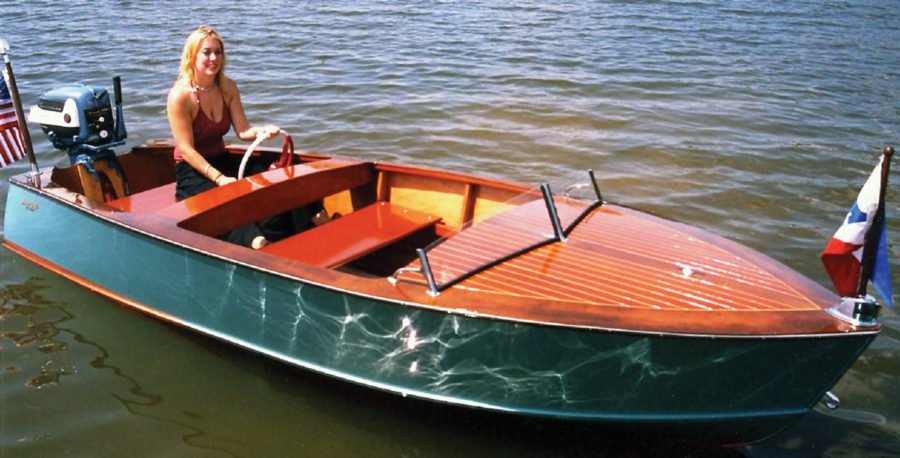
Small Boats Annual 2007
From the 2007 Small Boats Annual - Already a monumental success in 1950, Chris-Craft thought to use up their mountain of mahogany scrap by cutting kits for handsome plywood power…
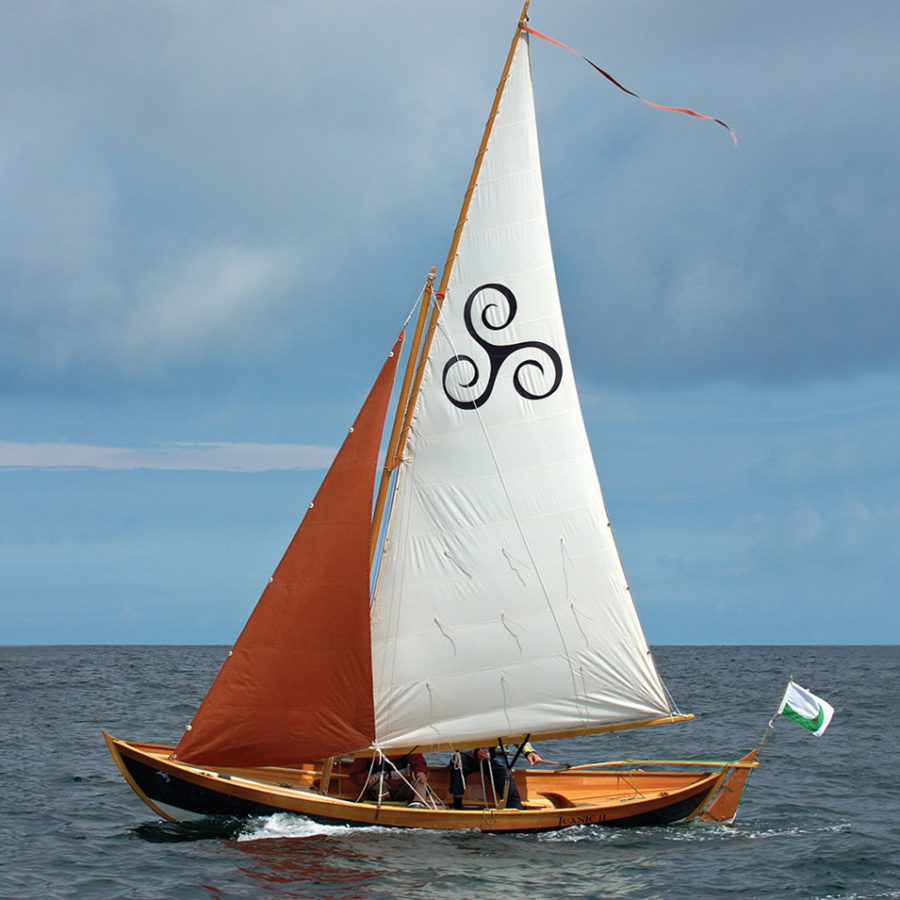
The Ness Yawl
From the 2007 Small Boats Annual - Few boats developed from a traditional working boat are as adaptable to small boat sailing as a Ness Yawl, and few are as…
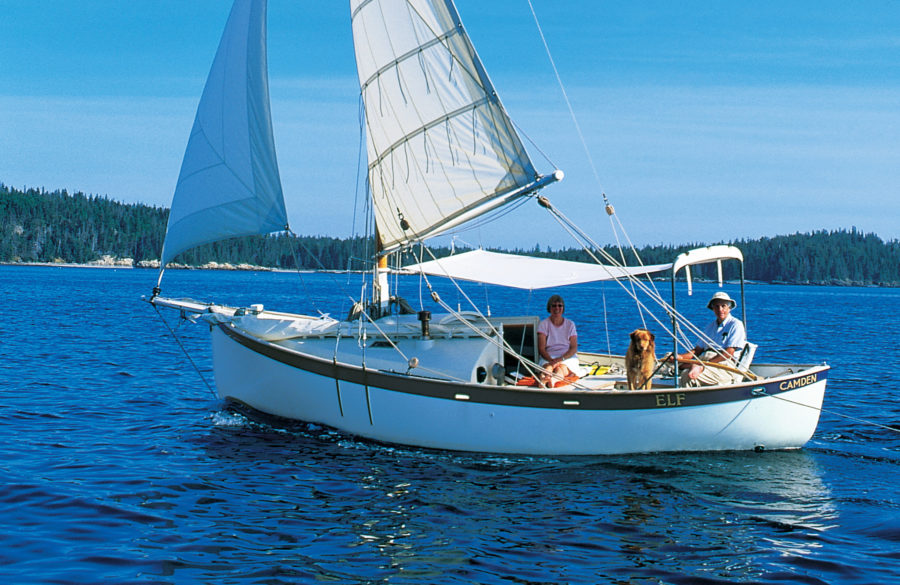
From the 2007 Small Boats Annual - Paul Gartside's plans for modest-sized cruising boats inspired by the Falmouth cutters of his native England should all come with one of those…
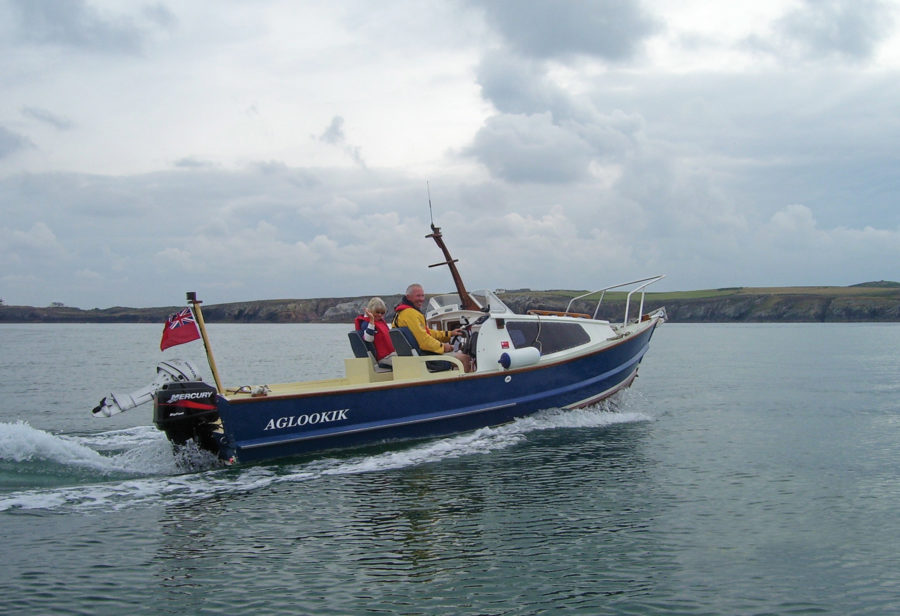
The Tolman Skiff
From the 2007 Small Boats Annual - Renn Tolman designed his eponymous skiff as a workhorse for rugged Alaskan environs. The boat has proven to be adaptable to a wide…
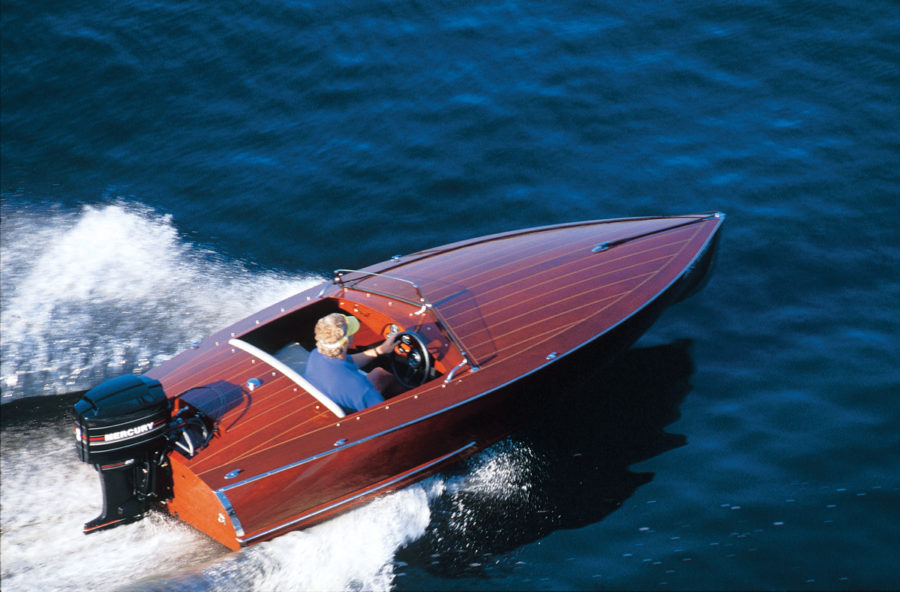
From the 2007 Small Boats Annual - RASCAL sped across the riffled waters of Long Island Sound. Her mahogany foredeck glowed from the depths of its varnish, and her stainless-steel…
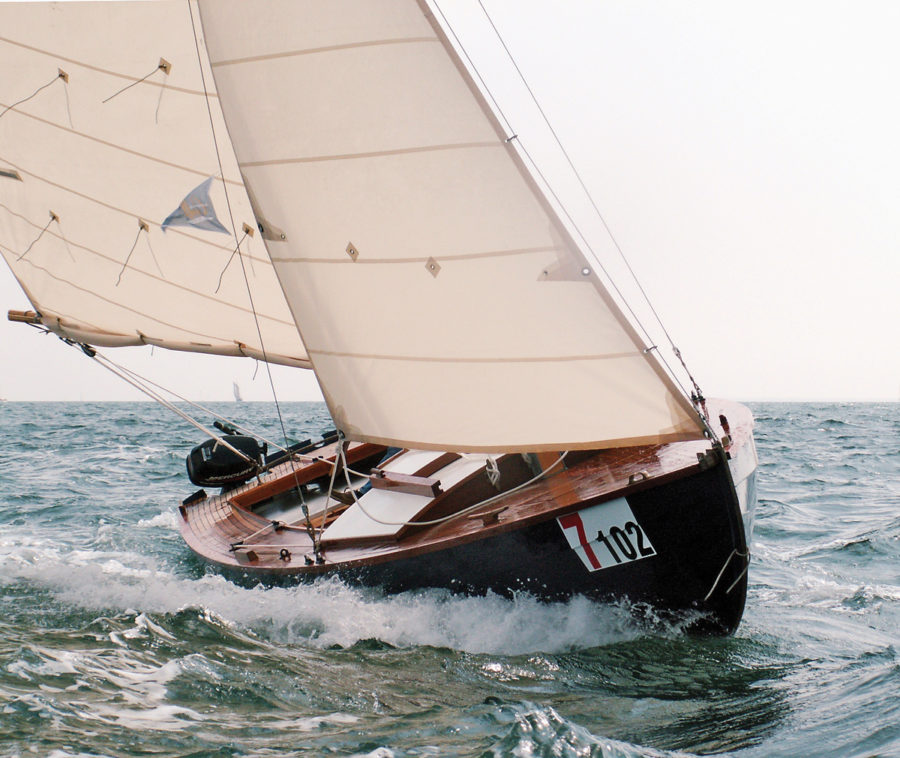
From the 2007 Small Boats Annual - With his Stir Ven design, a 22' LOA center- boarder, François Vivier took first place in the “neo-traditional” category of a 1997 design…
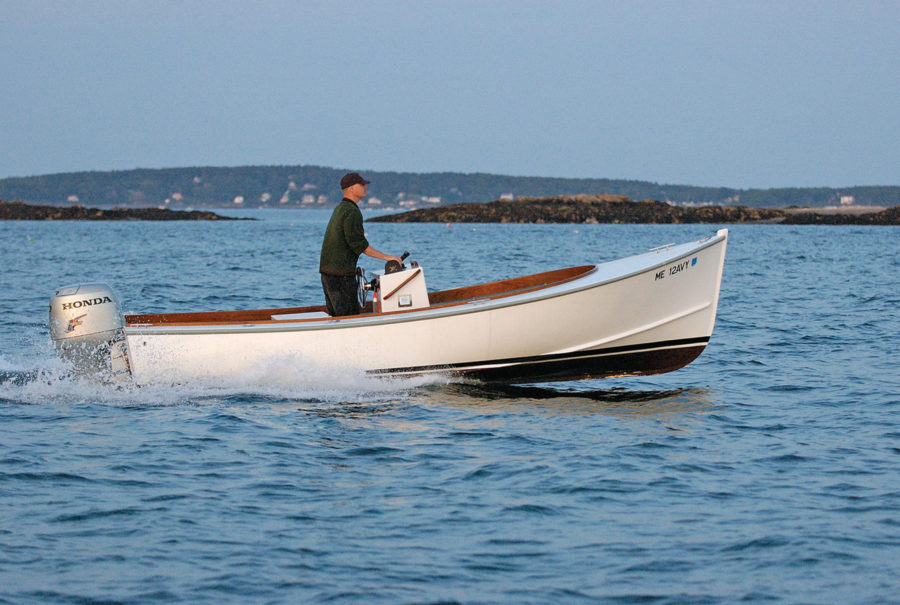
The West Pointer 18
From the 2007 Small Boats Annual - Six River Marine based this tough and shapely skiff on a highly regarded workboat designed and built by Alton Wallace. Chip Miller gave…
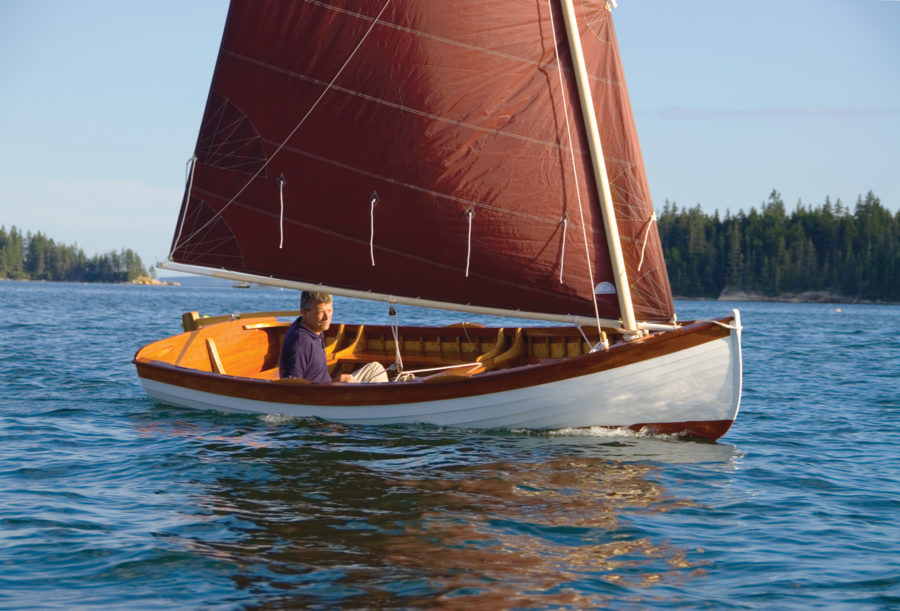
From the 2007 Small Boats Annual - Skylark was designed by Paul Gartside for day-sailing in the sporty estuary and ocean waters off the Oregon coast. With a 14' length…
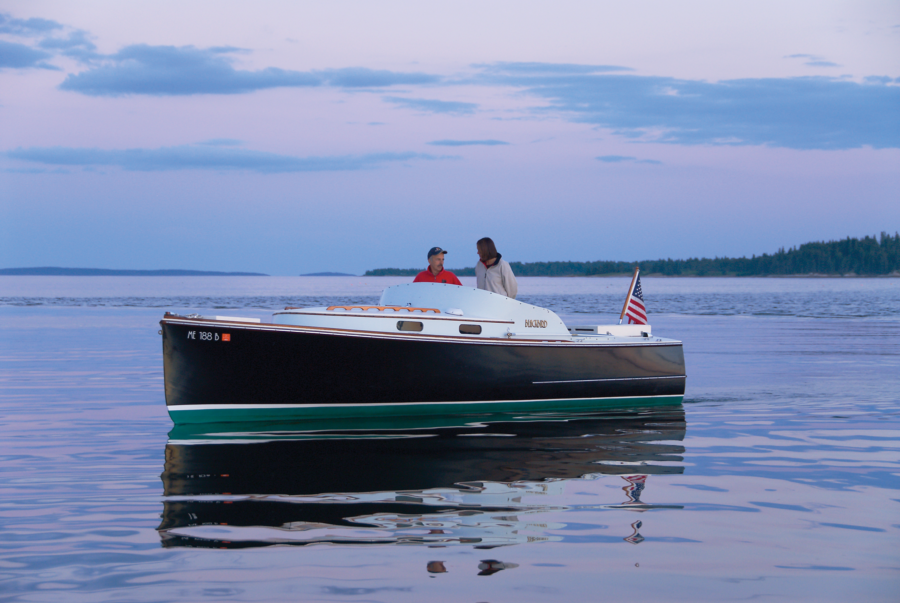
From the 2007 Small Boats Annual - Conceived in the early 1980s by Ken Bassett, Onion River Boat Works, and massaged into her final form by Phil Bolger, BLACKBIRD embodies…
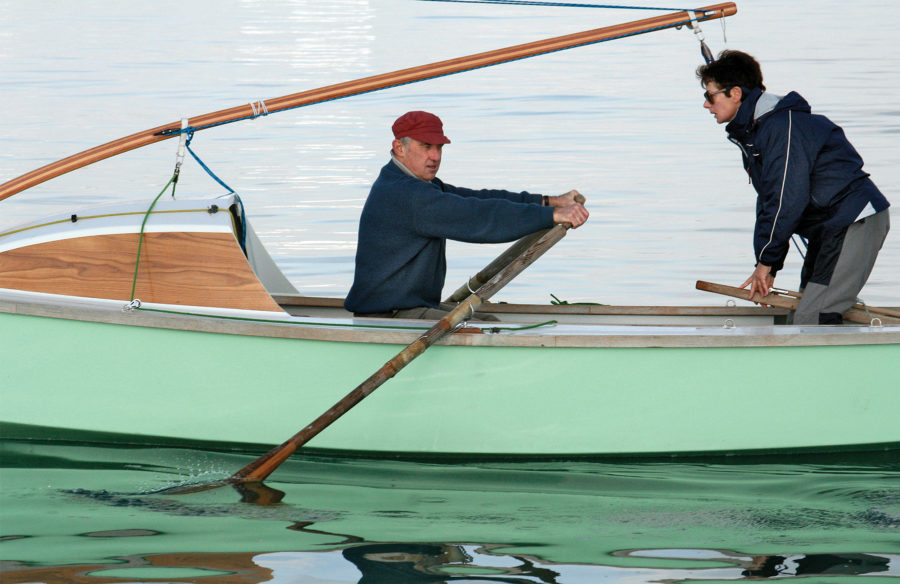
From the 2007 Small Boats Annual - PETITELISA is a synthesis of Gilles Montaubin’s long experience with sail-and-oar boats. Unlike many boats of this type, she is not reminiscent of…
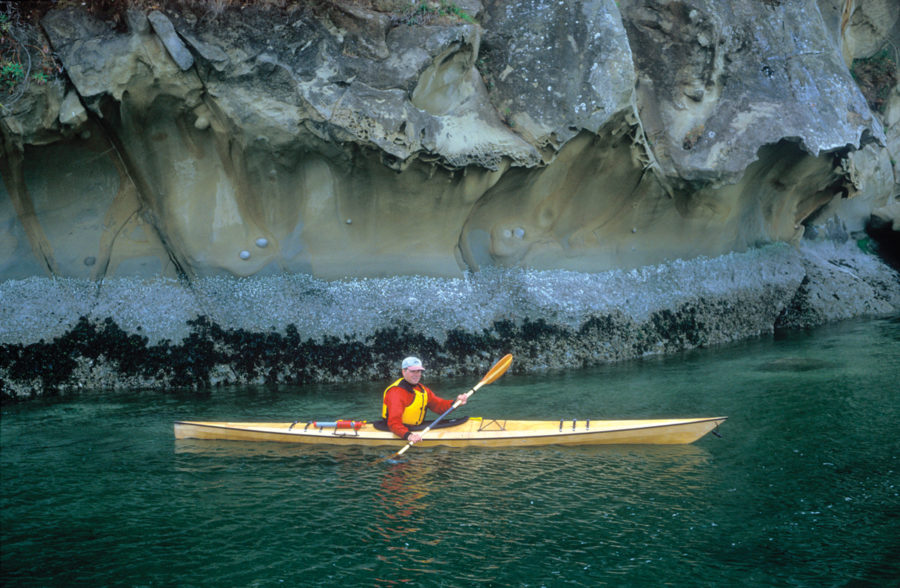
From the 2007 Small Boats Annual - People are always drawn to the warmth and the visual texture of a varnished wood kayak, but the beauty of a plywood kayak…
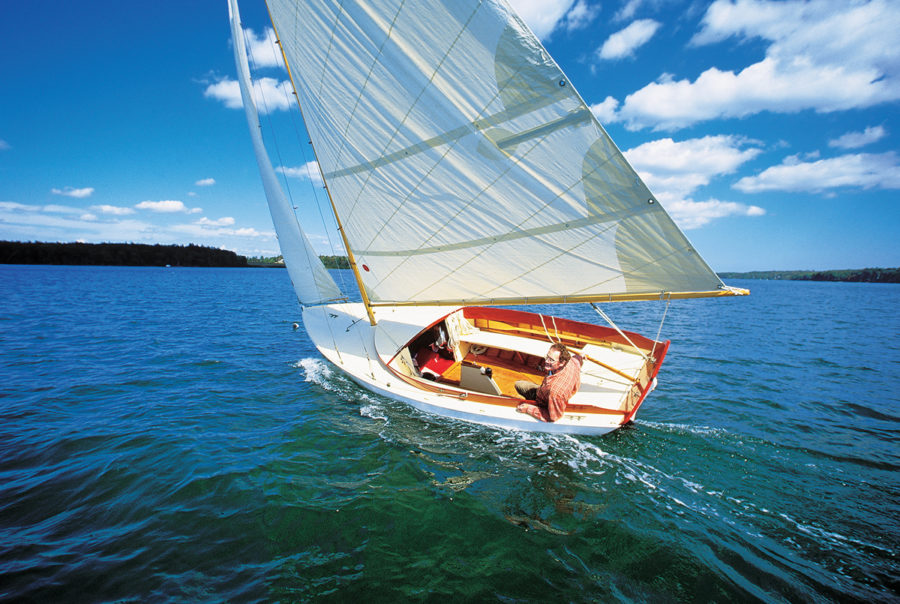
From the 2007 Small Boats Annual - Every sailor has his own vision of the perfect daysailer. For many, this ideal boat is based on the Herreshoff 12 1⁄2, Nathanael…
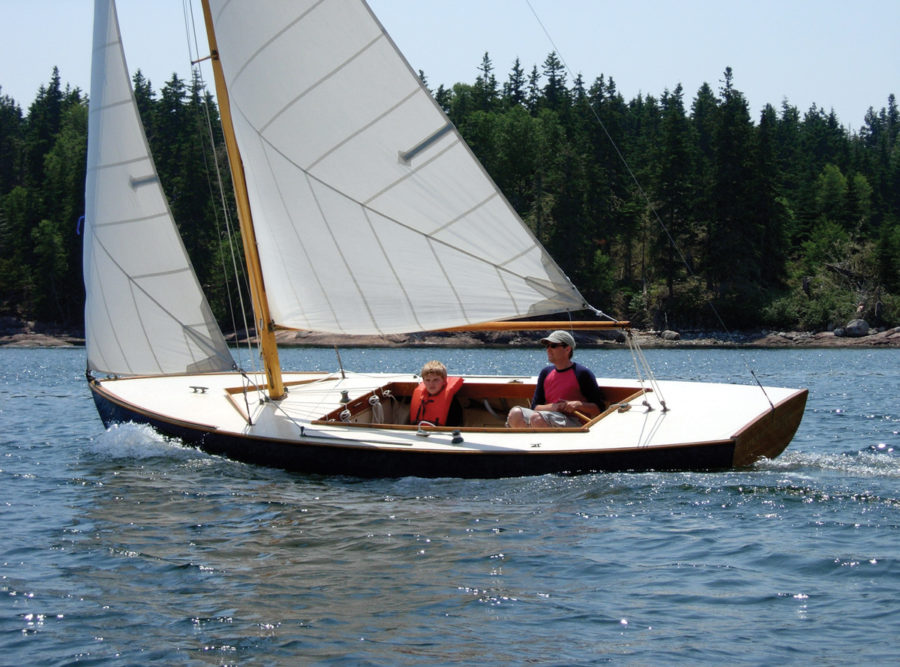
The Boothbay Harbor One-Design
From the 2007 Small Boats Annual - The Boothbay Harbor One-Design, a short-ended Burgess, moved to mid-coast Maine and hired Geerd daysailer with a long waterline, is a particularly handsome…
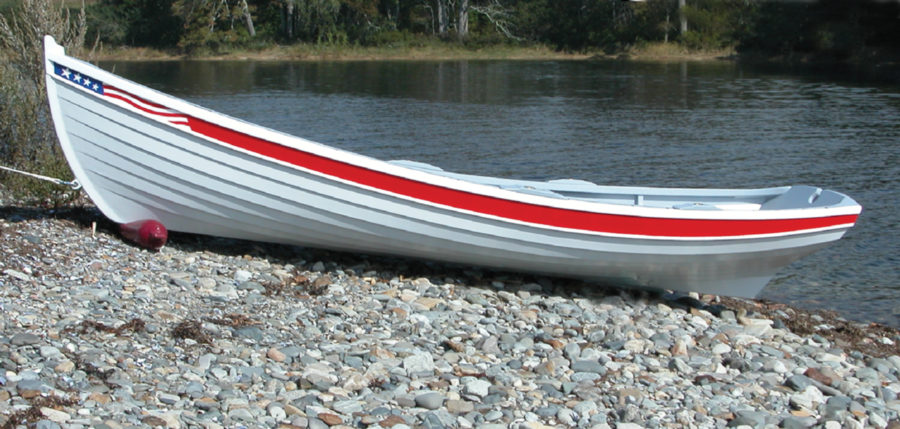
The Christmas Wherry
From the 2007 Small Boats Annual - The Christmas Wherry possesses two characteristics that should be critically important to anyone looking for a small boat to use in open waters.…
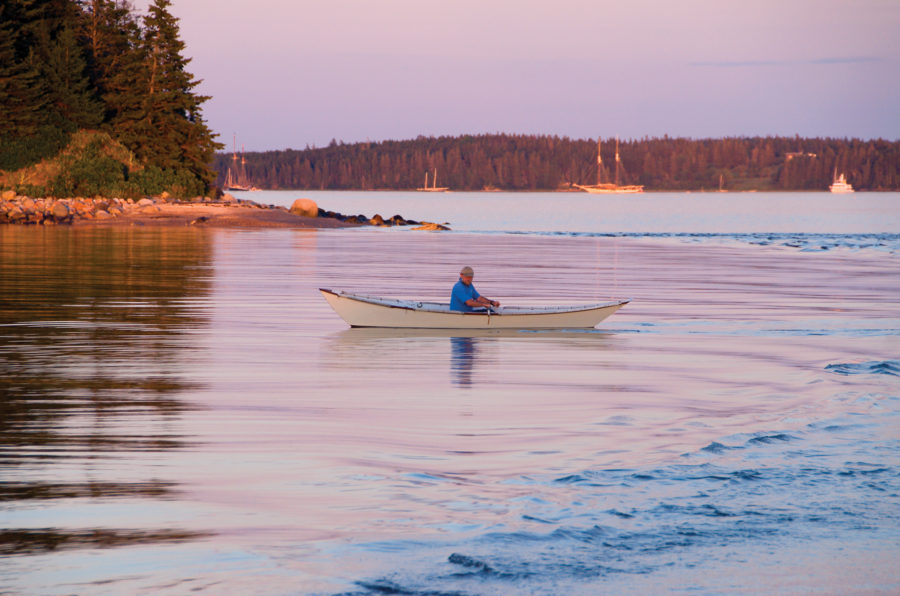
The Gloucester Light Dory
From the 2007 Small Boats Annual - In the early 1980s, I bought Phil Bolger’s plans for the 15′ 6″ LOA Gloucester Light Dory. I was living in an apartment…
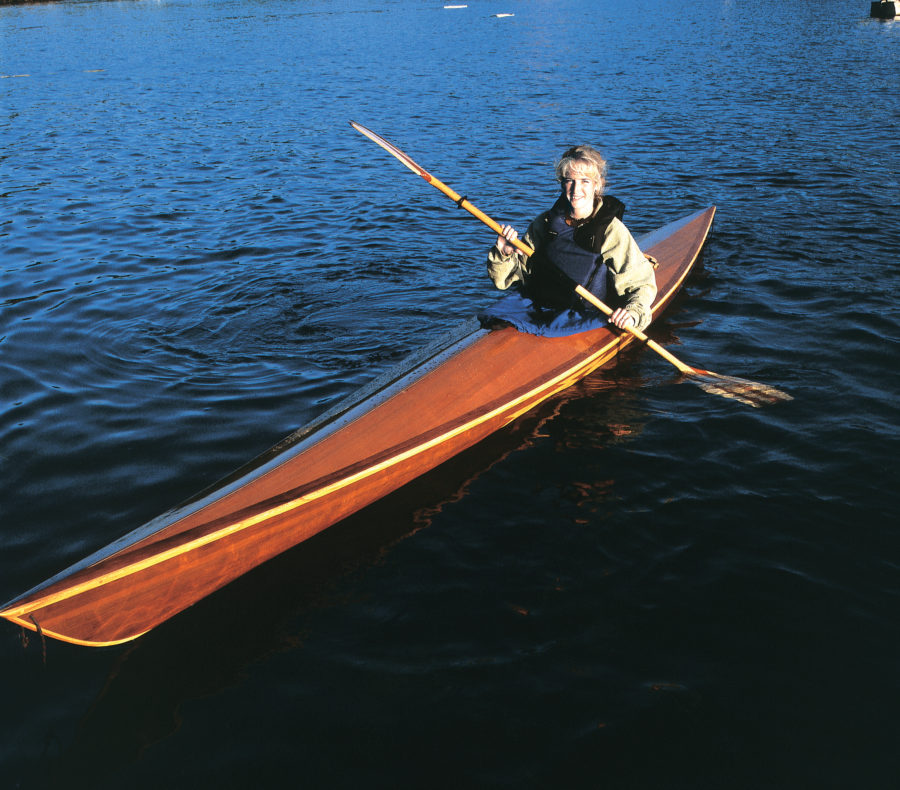
Endeavour 17
From the 2007 Small Boats Annual - The Steve Killing–designed Endeavour 17, a kayak built of cedar strip planks and fiberglass, combines beauty, fast lines, load-carrying capacity, and relatively easy…
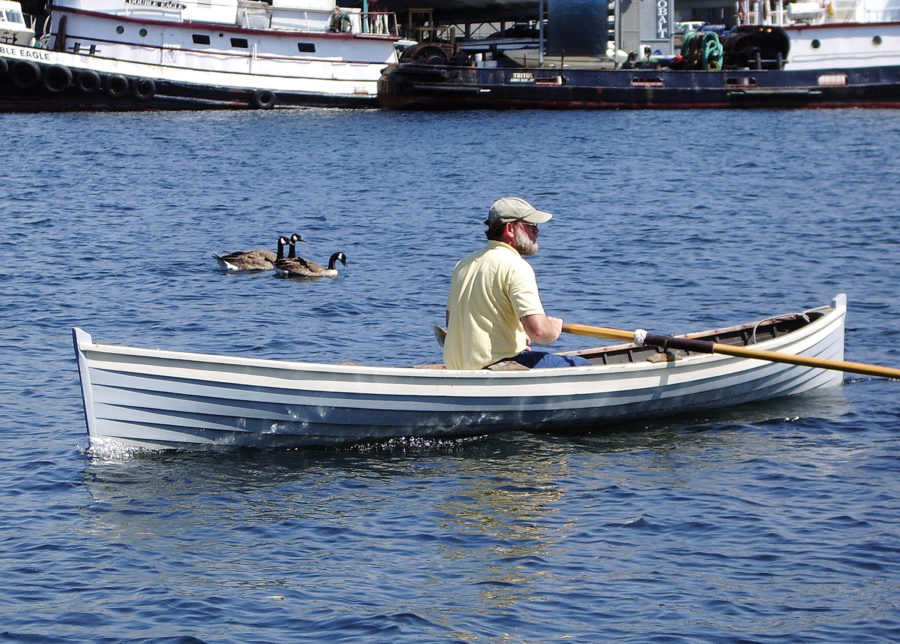
The Lake Oswego Boat
From the 2007 Small Boats Annual - Few joys in life are simpler than a morning row. Oars over the shoulder, hollow footsteps along a wood-decked float, the boat quivering…
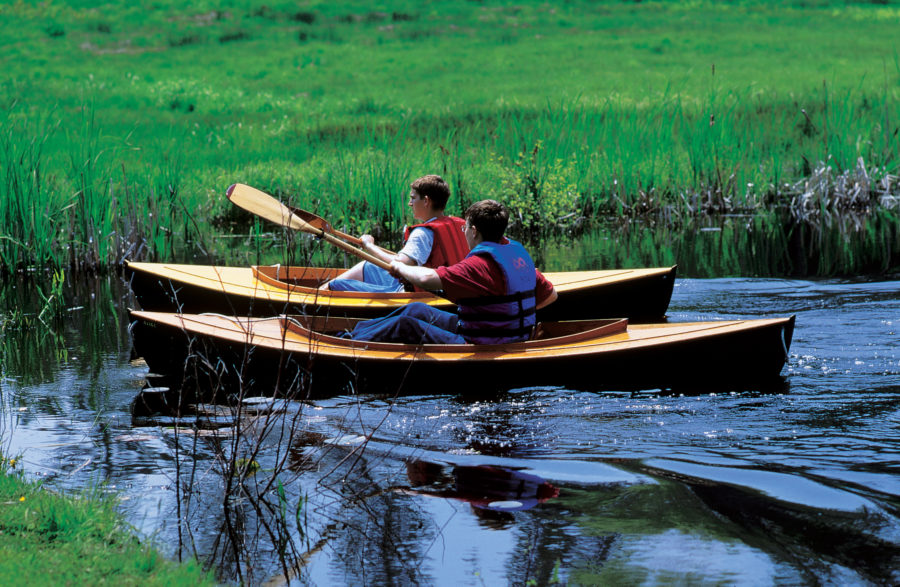
From the 2007 Small Boats Annual - Harry Bryan, a boatbuilder and designer from New Brunswick, Canada, designed the Fiddlehead, a 10 1⁄2' double-paddle canoe, in 1992 after his sister-in-law…
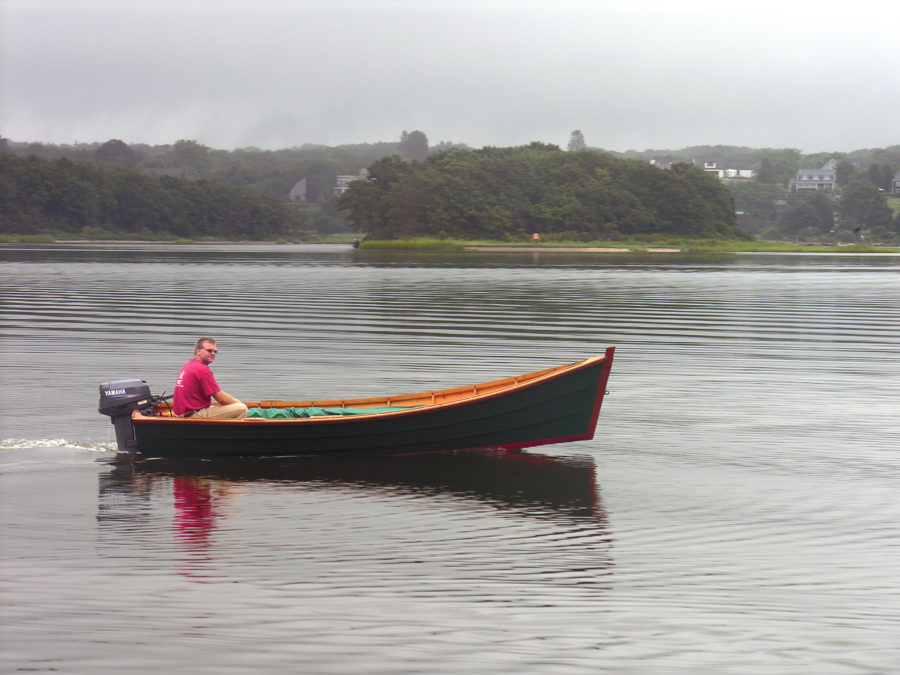
The Macomber 15
From the 2007 Small Boats Annual - You can walk across the Westport River in southern Massachusetts at low tide. It's a mile or so across in some places, but…
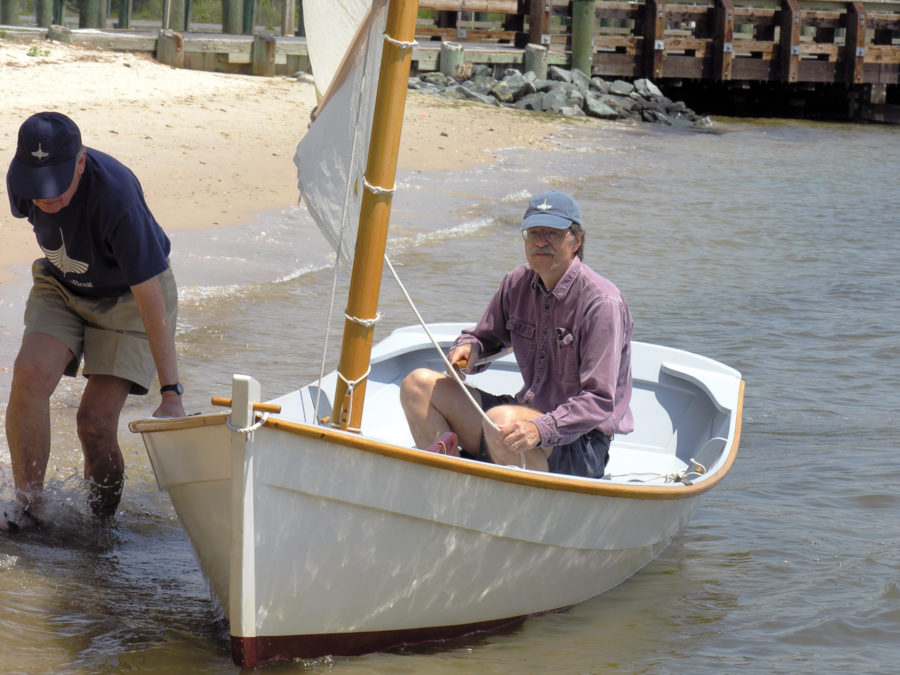

The Sailing Skiff 15
From the 2007 Small Boats Annual - All youngsters might begin their waterborne adventures in flat-bottomed rowing/sailing skiffs. Easy to build, but difficult to design properly, these honest little boats…
The WindSprite 26
From the 2007 Small Boats Annual - Frank Pedersen designed a light-displacement planing hull, and WINDSPRITE's abilities as a performance daysailer have been anything but a disappointment to him. With…
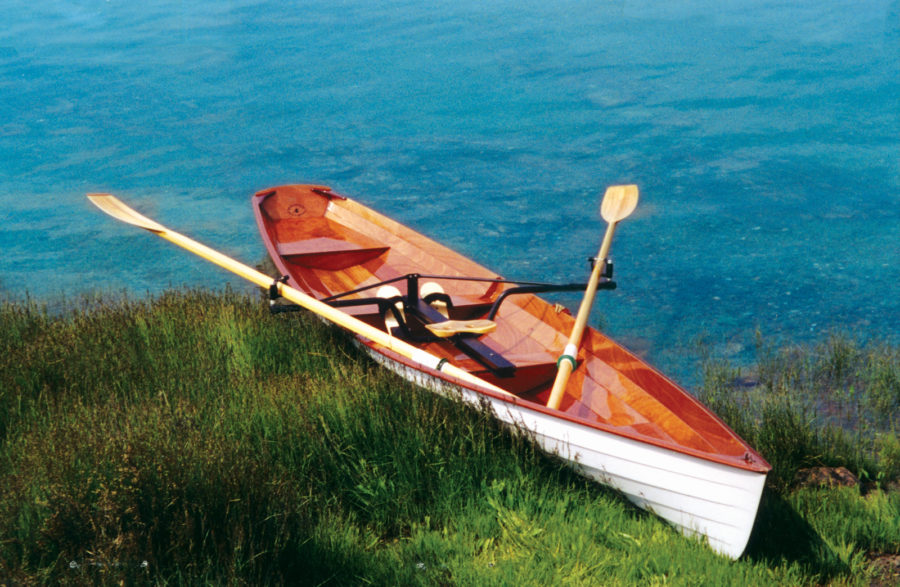
The Annapolis Wherry
From the 2007 Small Boats Annual - Faster than a typical skiff, yet more stable than a recreational shell, the light (65 lbs) Annapolis Wherry from Chesapeake Light Craft offers…
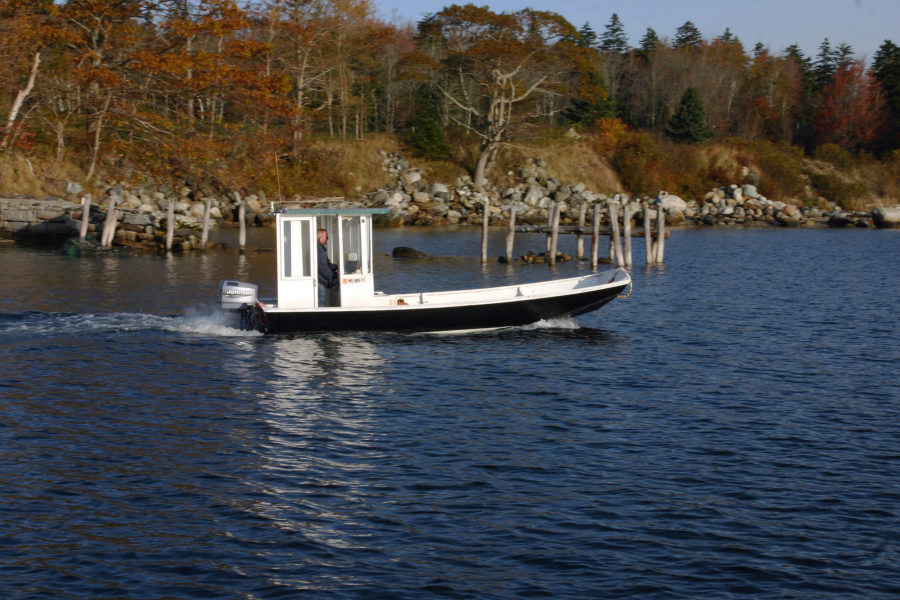
The Ben Garveys
From the 2007 Small Boats Annual - Boats don’t always need to have pointy forward ends. Here we have two easily built, square-ended workhorses that will handle all sorts of…
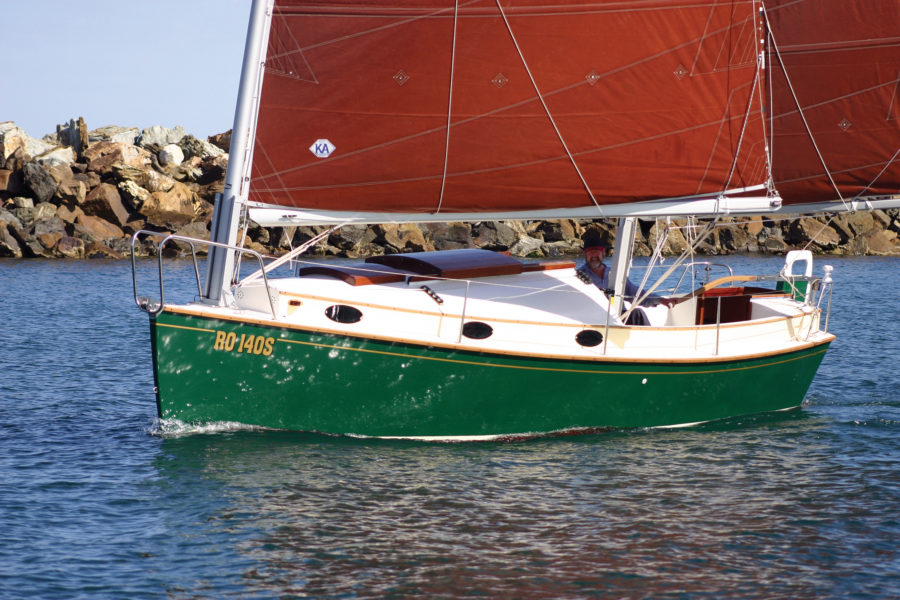
The Norwalk Islands 26
From the 2007 Small Boats Annual - The sheet-plywood Norwalk Islands Sharpie can easily be built in the backyard, yet it outperforms more expensive yachts. Its simple cat-ketch rig needs…
More SeriesSmall Boats Annual 2007
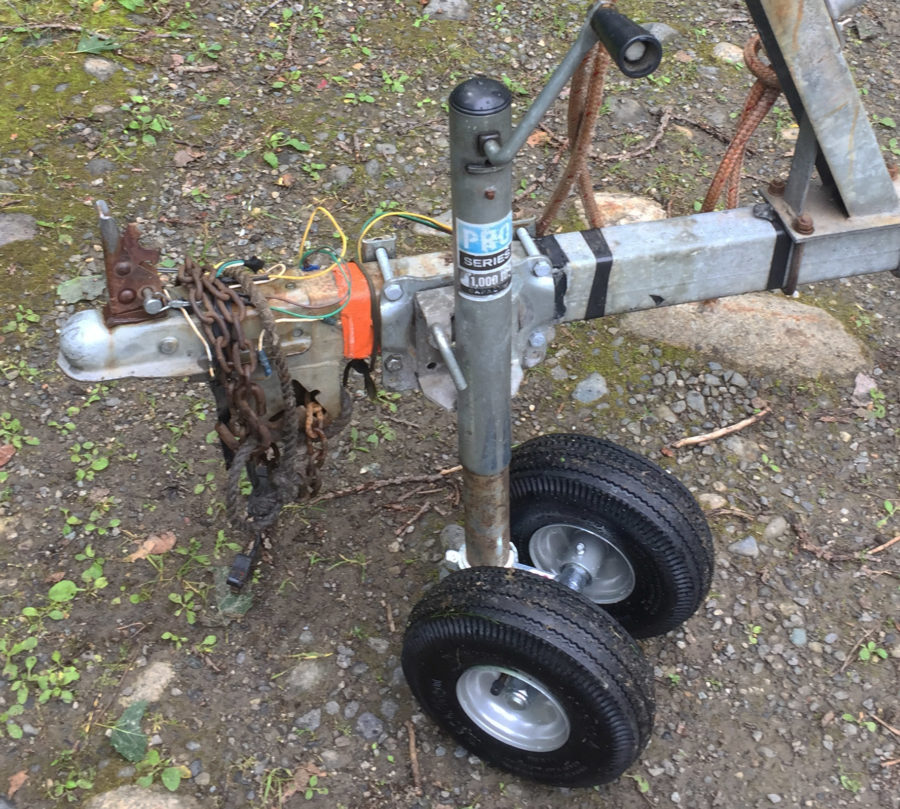
Product Reviews
Rolling Relief for Boat Trailers
Croft makes a pneumatic-wheel kit with dual 10″ wheels. The plated-steel hubs have grease fittings to lubricate the axle and bushings. Between the wheels is a plated-steel caster plate with…
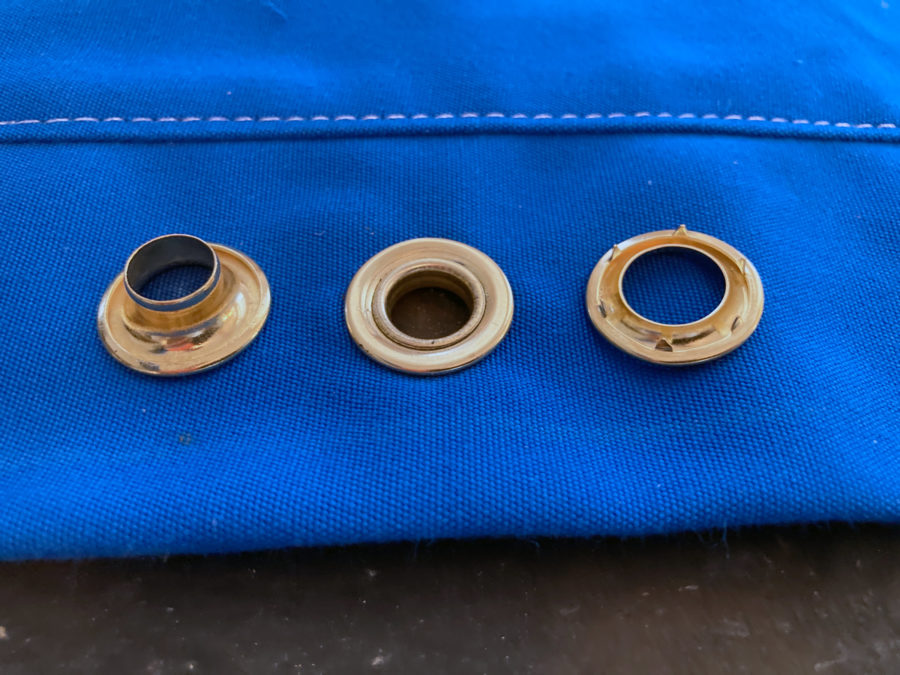
Spur Grommets
Spur grommets can be put under loads that would tear out plain grommets and can be set in sailcloth, canvas, leather, webbing, and many other materials. They have two parts:…
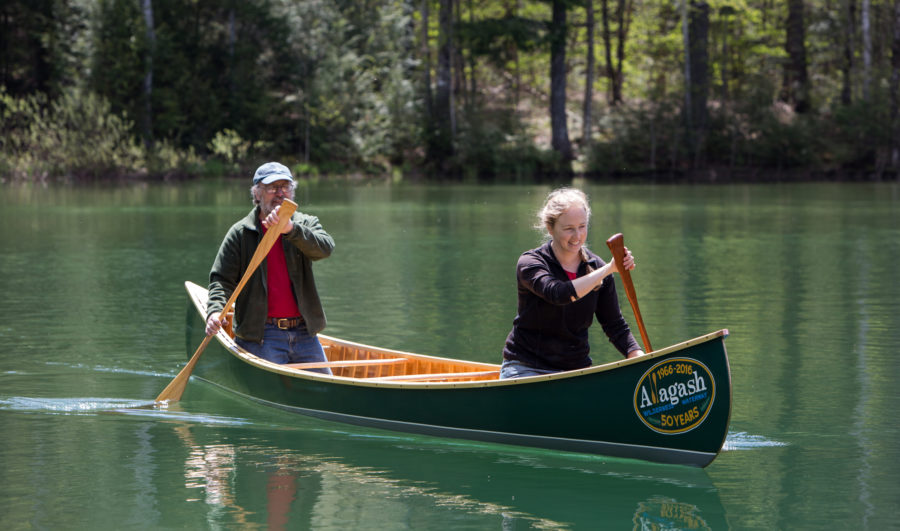
Boat Profile
Atkinson Traveler
Rollin Thurlow has been building and restoring wood-and-canvas canoes for 38 years. This spring, Rollin took a short break from his shop, the Northwoods Canoe Company in Atkinson, Maine, to…
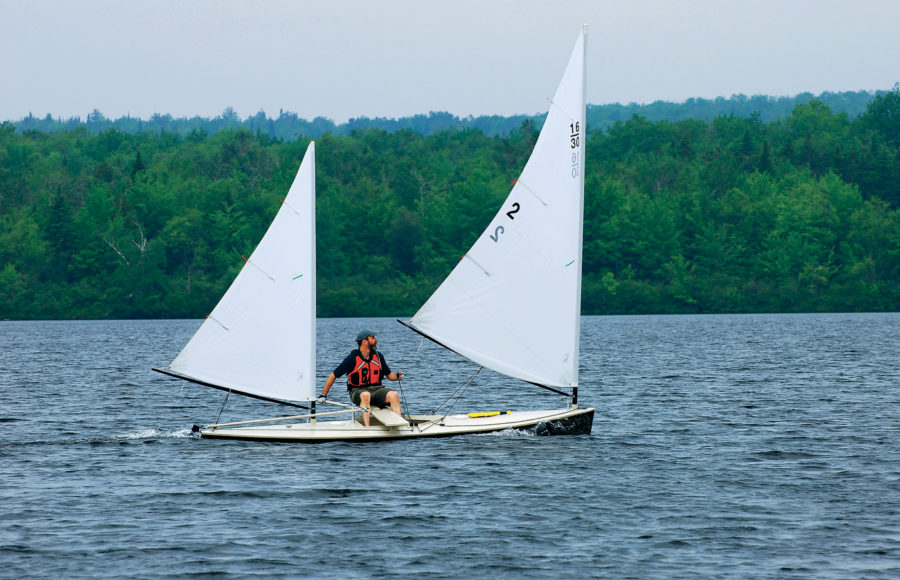
Small Boats Annual 2009
The 16/30 Sailing Canoe
From the 2009 Small Boats Annual - The 16/30 class sailing canoe is the product of a long-term project on the part of John Summers, General Manager at the Canadian…
Subscribe Today!
Become a subscriber today and you’ll recieve a new issue every month plus unlimited access to our full archive of backlogged issues.
Already a subscriber? Sign In
Subscribe For Full Access
Flipbooks are available to paid subscribers only. Subscribe now or log in for access.

- New Sailboats
- Sailboats 21-30ft
- Sailboats 31-35ft
- Sailboats 36-40ft
- Sailboats Over 40ft
- Sailboats Under 21feet
- used_sailboats
- Apps and Computer Programs
- Communications
- Fishfinders
- Handheld Electronics
- Plotters MFDS Rradar
- Wind, Speed & Depth Instruments
- Anchoring Mooring
- Running Rigging
- Sails Canvas
- Standing Rigging
- Diesel Engines
- Off Grid Energy
- Cleaning Waxing
- DIY Projects
- Repair, Tools & Materials
- Spare Parts
- Tools & Gadgets
- Cabin Comfort
- Ventilation
- Footwear Apparel
- Foul Weather Gear
- Mailport & PS Advisor
- Inside Practical Sailor Blog
- Activate My Web Access
- Reset Password
- Customer Service

- Free Newsletter

Tartan 30: An Affordable Classic

Ericson 34-2 Finds Sweet Spot

How to Sell Your Boat

Cal 2-46: A Venerable Lapworth Design Brought Up to Date

Solar Panels: Go Rigid If You have the Space…

Leaping Into Lithium

The Importance of Sea State in Weather Planning

Do-it-yourself Electrical System Survey and Inspection

When Should We Retire Dyneema Stays and Running Rigging?

Rethinking MOB Prevention

Top-notch Wind Indicators

The Everlasting Multihull Trampoline

What Your Boat and the Baltimore Super Container Ship May Have…

Check Your Shorepower System for Hidden Dangers

DIY survey of boat solar and wind turbine systems

What’s Involved in Setting Up a Lithium Battery System?

Waste Not is the Rule. But How Do We Get There?

The Scraper-only Approach to Bottom Paint Removal

How to Handle the Head

The Day Sailor’s First-Aid Kit

Choosing and Securing Seat Cushions

Cockpit Drains on Race Boats

Re-sealing the Seams on Waterproof Fabrics

Safer Sailing: Add Leg Loops to Your Harness

Waxing and Polishing Your Boat

Reducing Engine Room Noise

Tricks and Tips to Forming Do-it-yourself Rigging Terminals

Marine Toilet Maintenance Tips

Learning to Live with Plastic Boat Bits
- Sailboat Reviews
A Herreshoff Legacy Lives On
Count the stuart knockabout among the few to hold its value..
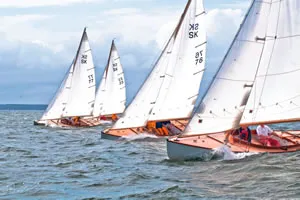
Photos by Ralph Naranjo
It took some time for the Stuart Knockabout, an L. Francis Herreshoff design, to take root and finally flourish. The 28-foot day boat first appeared in 1932 as line drawing number 53 in the L. Francis annals, and only one boat was built. In 1933, Ben My Chree (a Galic term of endearment), was launched and wound up nestled away in Casco Bay, Maine, at the island home of owner Willoughby Stuart. With its own small marine railway and boat shed, Ben My Chree remained in the family for nearly 40 years. In the mid-1980s, it was discovered in a Massachusetts boat shed by Bill Harding, a sailor known for his deft hand on the tiller and the builder of the popular Herreshoff 12 replica-affectionately known as the Doughdish. Harding fell for the lines of daysailer he had discovered, and he researched the boats lineage. After getting a feel for what it had to offer under sail, he decided that this was another slice of sailing history that deserved being resurrected.
Harding built molds and used his already proven approach to turning a timber Herreshoff into a fiberglass favorite. To accomplish the goal, he once again went to boat builders Edey and Duff to do the hull and deck laminating and Ballentines Boat Shop to harness its carpentry skills and talents in finishing off these elegantly trimmed knockabouts. Today, Ballentines handles all the manufacturing and marketing, and even puts on the annual national championship. There are more than 80 boats sailing in the wake of Ben My Chree, and the reason for their success centers around how the boat was originally designed, where it is built today, and why it will continue to sail into the future.
While nearly every major New England boatbuilder is offering a contemporary classic daysailer today (see PS January 2009 online), the Knockabouts long production run and coast-to-coast following give it an investment appeal that you seldom see in the world of sailboats-of any size. For a retired cruiser looking to downsize to a daysailer, this reason alone should bump the Stuart Knockabout up into the final round of hulls under consideration.
What makes this boat such a pleasure to sail has as much to do with whats missing as whats included. This sloop has been stripped to its essence, not a parsimonious approach to boat building, but rather one in which a fine pedigree is created from the foot of the keel to the top of the mast. There is also a startling difference between most contemporary, 28-foot production sailboats and the Stuart Knockabout. The latest luxury daysailers are accessorized with a cabin, bunks, galley stove, a small diesel-plus tanks to fill with water and fuel. While daysailing, the engine coaxes the boat on and off the mooring, and all too often, is a substitute for light-air sails. But for many, the bunks go unused and the stove remains cold for months at a time. The tanks grow their own plankton. In the end, the owners are lugging around a lot of unnecessary structure that shrinks the cockpit, lowers the waterline, raises the center of gravity and kicks up the cost along with the annual maintenance invoices. In short, more boat isn’t necessarily more fun.
The L. Francis Herreshoff design No. 53 defines a shoal draft, 28-foot centerboard/sloop. It has shallow draft (2 feet, 9 inches centerboard up and 5 feet, 6 inches centerboard down), sporting an impressive 50-percent ballast ratio that recoups the righting moment trade-off in the commitment to shallow draft and a lean (6-foot, 11-inch) beam hull. This results in good sail-carrying ability, and is why the Stuart Knockabout, like many of Herreshoffs designs, can make the most of long waterlines, a classic modified spoon bow, and fine sections aft. The net result is a 22-foot, 10-inch resting waterline that grows considerably with just a small amount of heel or squat, and an easily driven hull that can cope with breeze and chop, despite its low freeboard.
The Marconi mainsail and small clubfooted jib yield a combined 265 square feet of working sail area. This is fairly small by Herreshoffs (and todays) standards, but its clean hull lines provide adequate light-air efficiency, especially with the genoa substituted for the self-tacking working jib. An asymmetric spinnaker rounds out the light-air inventory, and even with the relatively low-aspect rig and moderate amount of sail area, the sloop starts moving with little more than a zephyr and is a delight to sail throughout a wide wind range. A J/80 crew will wave as they go by, but after a couple of hours, those lads leaning against the lifelines will envy the knockabout crew sitting in the cockpit snacking or sharing a tasty lunch.
The boats a made-in-America tale of Yankee tradition. Today, Hall Spars does the rig, and its just the right combination of alloy spar, low-maintenance reliability, and a buff-color traditional finish that conveys aesthetics and good performance. Even the sensibility of traditional three-strand, easy to splice, running rigging fits the equation. Edson casts the traditional bronze hardware, and provides the pump thats set deep in the bilge.
With a rail-to-rail traveler on the aft deck and a mainsail vang, theres plenty of opportunity to optimize mainsail shape and trim. The ballast-derived righting moment and moderate sail area keep the crew from scrambling to the rail as the breeze builds. One of the many appealing design attributes found in this boat is the way sailing remains civilized-an in-the-cockpit experience rather than a hang-over-the-rail tribulation. Even when the breeze pipes up, the moderate sail area and high ballast ratio locks in a welcome stiffness, and it justifies lugging around 2,400 pounds of lead ballast in a 4,000-pound boat. The modern foam/fiberglass sandwich hulls and decks weigh less than the original hulls and the ballast has been upped a bit adding extra stiffness.
The proclivity to heel is the Achilles heel of boats built with non-self-bailing cockpits. In this case, the Stuarts high coamings combine with its stiff countenance to prevent the down-flooding linked to a deep knockdown, a very unlikely occurrence. The crew at Ballentines add buoyancy (foam aft and a water-tight bulkhead in the stem) to keep a swamped hull on the surface. According to well-kept Ballentine records, one boat was actually caught in the vortex of a tornado moving over a lake with winds well over 100 knots. The boat was knocked down and swamped, but the owners were surprised at how well the built-in flotation kept it on the surface and upright, despite the flooded hull.
The Stuart Knockabout is a sailboat that looks as good underway as it feels at the helm. A long, carefully sculpted, varnished locust tiller delivers a fingertip feel. Observers note that even with the slightest bit of heel, the well-proportioned sloop stretches its waterline just enough to settle into the seaway and shoulder the waves without excess pitching. The long tiller affords enough leverage to eliminate any barn-door effect from the low-aspect-ratio attached rudder. The long run of keel and forefoot cutaway are in harmony with the sail plan. This results in on-the-wind sailing that could be described as balanced, and off-the-wind sailing that is a nicely controlled endeavor.
The large-main/small-jib sail plan is in complete harmony with the underbody. As the breeze increases, the Knockabout heels gradually and remains reluctant to go much beyond 15 to 20 degrees. Naturally, big increases in wind velocity, such as during a thunderstorm, can result in being overpowered. Like any sailboat, its not immune to fire drills.
Under power
The Stuart Knockabout is a prime candidate for an electric Torqueedo outboard or a small 3- or 4-horsepower, long-shaft four-stroke outboard. A port mounting bracket is fitted near the tiller, and the low freeboard gives the outboard plenty of prop submersion. When the engine is not in use, its easy to haul it back aboard, remove the bracket and stow the motor and bracket under the foredeck.

Pocket cruisers are indeed one of the most worthy ways to voyage under sail. But if your stints on the water are measured in hours not days, weeks, or months, why lug along a cabin and all that goes into such an interior? Look around your marina or out at the moored fleets, and tally up how often you see folks perched uncomfortably atop the cabin houses because the cockpit is nearly nonexistent. Add up how many of the capable cruisers return home to their slips in the late afternoon rather than swing-on-the-hook in a quiet cove. Designers and builders have been noting this trend, and the result has been a resurgence in capable sailing, large cockpit, daysailers. But rather than shell out $80,000 (or much more) for one of these new iterations, an option is to track down an old Stuart Knockabout. The Knockabout has both the enduring appeal of a classic and the design advantages of a true daysailer. It is a sailboat that has indeed had multi-generational appeal.
In the just under and just over 30-foot size boat, youll find cruisers, racers, and everything in between. Its this tween range that got us going this month and led to our close scrutiny of the Stuart Knockabout. The boat is neither a cruiser, nor a racer for the adrenalin-dripping sailor hoping to keep up with the kiteboarders. The Stuart works for those looking to savor a couple of hours of an afternoon sea breeze or a bit of local club racing. How she compares with a couple of other boats we call daysailers is worth mentioning. (See In Context table on right.)
The new CW Hood 32 is an elegant, and technically tricked-out, long-ended daysailer. With a carbon rig and vacuum-bagged molded hull, it has a few feet on the Stuart and still comes in lighter in displacement. Its Performance Handicap Racing Fleet (PHRF) rating of 147 will appeal to the race-oriented, as will the carbon spar and rod rigging.
The out-of-production J/80 is more of a one-design racer than leisure daysailer, and its proven ability under sail has a lasting legacy. Over 1,300 boats have been launched, and the used price for a sound boat is about $35,000. The new J/Boats that bracket the J/80 are the smaller, 22-foot J/70 speedster ($50,000) and the 29-foot, auxilliary-diesel powered J/88 ($150,000). Both are fine boats, but they offer less than an apples to apples correlation with the Stuart Knockabout.
The bottom line, at least from our perspective, is that although sailboat design and technological advances have moved ahead, and made for performance enhancements that count on the race course, the delight of simply being underway in a tried and proven traditional design still has merit.
Theres a lot to appreciate about a boat thats easy to handle, leaves just a few ripples in her wake, and is as pleasant to look at as she is to sail.
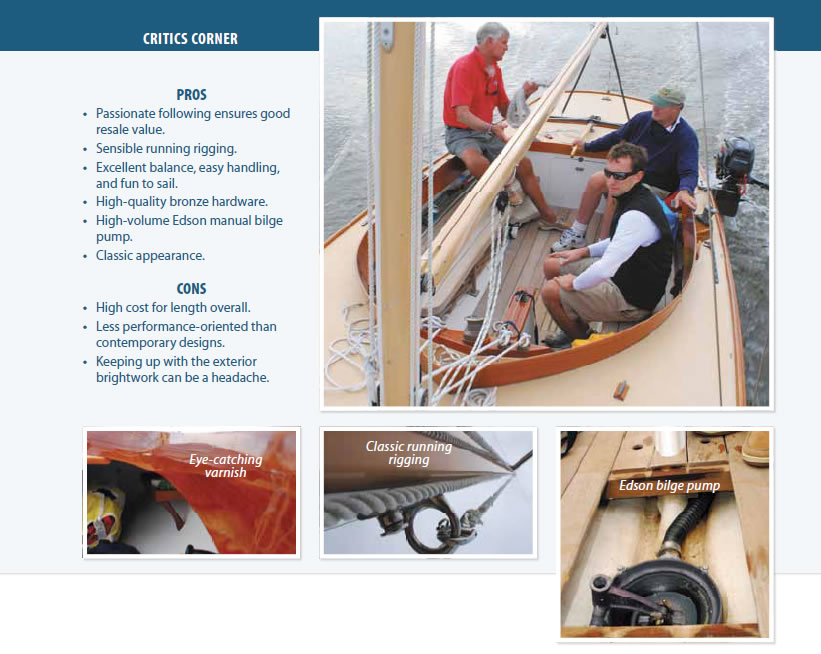
- Craftsmanship is at the Heart of Construction
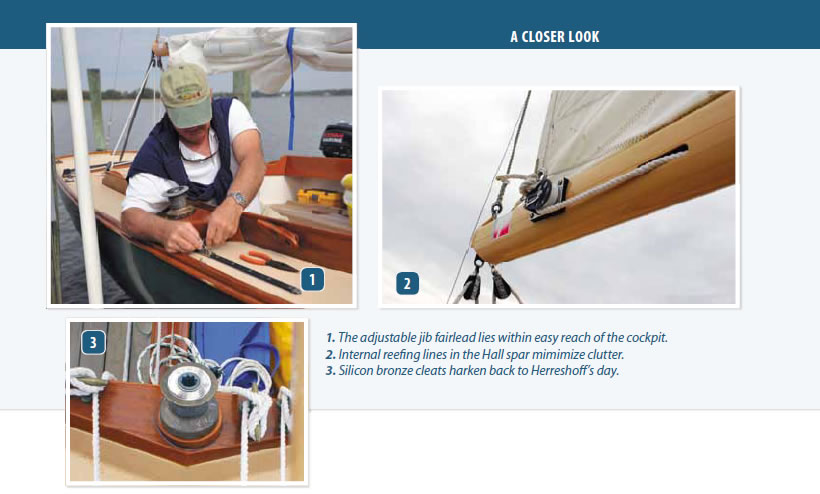
The Stuart Knockabout’s performance ratios mark it as more conservative than contemporary daysailors.
- Ballentine’s Boat Shop
RELATED ARTICLES MORE FROM AUTHOR
Leave a reply cancel reply.
Log in to leave a comment
Latest Videos

Fuel Contamination? The Baltimore Francis Key Bridge Collapse

Safety At Sea For You & Your Family – The Joe...

What’s The Best Vinyl Window Cleaner for Your Boat?

40-Footer Boat Tours – With Some Big Surprises! | Boat Tour
- Privacy Policy
- Do Not Sell My Personal Information
- Online Account Activation
- Privacy Manager

L. Francis Herreshoff H-28 Ketch
Just two owners in 47 years.
Professionally maintained by Cutts and Case in Oxford, Maryland for the last 11 years.
Frequent exhibit boat at annual Sultana Downrigging Weekend in Chestertown since 2012.
“Simplicity afloat is the surest guarantee of happiness.”
– L. Francis Herreshoff
One of LFH’s most graceful designs, Gwylan is ready to begin turning heads in new harbors starting with the 2024 season.
LOA 28’
Sparred length: 34’
LWL 23’
Beam 8’9”
Draft 3’6”
Sail area: 343 s.f.
w/genoa approx. 546 s.f.
Built 1976 by McKie (Nick) Roth, Westport, Maine
White cedar over white oak, mahogany brightwork, bronze fastened, lead keel.
Reinforced 1998 with Cutts & Case's patented method which laces the planking below the waterline with thin Kevlar cord, resulting in an exceptionally safe and strong hull. No cracks in seams or planks in 26 seasons underway. See WoodenBoat #78 . No known rot.
Original Volvo-Penta MD7A diesel is well cared for, runs beautifully.
Sails made by the legendary Stuart Hopkins at Dabbler Sails, who crafted them from Dacron to look like vintage cotton: half-width panels (18") sewn with brown thread to catch the eye (and the camera), both jibs mitered to complete the vintage appearance. Sails are well maintained: main, mizzen, genoa, staysail. Includes a masthead drifter. Previous suit of sails are usable and are included.
Price $25,000, negotiable for a good home.
Ideal buyer has the skills and time to self-maintain or the availability of a competent yard.
You'll smile every time you look at her!
I have for 27 seasons.
She's now at Cutts & Case Shipyard in Oxford, Maryland, hauled for the season, stored indoors, among the many other beautiful boats in this classic yard.

See Drone Videos by Paul DeLaney
many more still images .

Authenticity
Gwylan closely follows LFH’s original design from the December, 1942 issue of the magazine The Rudder except for the welcome addition of a short bowsprit and removable jibstay to allow setting a big genoa in lighter air. It also is a handy place for the 25 lb. CQR anchor, which allows me to comfortably cruise singlehanded several hundred miles a year on the Chesapeake Bay and Delaware River.

The article was reprinted later in Herreshoff’s Sensible Cruising Designs ( still available )

L. Francis Herreshoff’s biographer, Roger C. Taylor, describes the development of the H-28 in his Volume II and he used two pictures of Gwylan in his excerpt article in Woodenboat No. 206 .
Author Roger Taylor on board Gwylan at Chestertown during Downrigging Weekend, 2016.
Gwylan’s first owner was a fascinating man, Capt. John Cadwalader, USN. In addition to being a lover of the sea, he was a professor of Shakespeare and a namesake descendent of one of George Washington’s generals in the American Revolution. The name Gwylan is the Welsh word for “seagull”.
She's sweet and true - prettiest boat in the harbor.

IMAGES
VIDEO
COMMENTS
If you have a length restriction at 14 feet, this is the sailboat you'll actually USE. (It has been largely supplanted by the LEVANT 15, which is larger and faster and owing to investments made by its builder, even cheaper) The PAINE 14 is a scaled-down adaptation of the venerable and much-loved Herreshoff 12 1/2, with a much lower wetted ...
LWL: 14′. Draft: 2′ 6″. Beam: 5′ 10″. Sail Area: 158.00 sq ft. Displacement: 1,700.00 lbs. This boat represents essentially the same concept as the Herreshoff 12 ½ enlarged and updated by L. Francis Herreshoff, the son of the 12 ½'s designer. She is a fair amount larger than the 12 ½, with more storage space and increased speed ...
Total sail area. 138 sq ft (12.8 m 2) ← Herreshoff 12½. [ edit on Wikidata] The Buzzards Bay 14 is an American sailboat that was designed by L. Francis Herreshoff and first built in 1940. [1] [2] [3] The Buzzards Bay 14 is a scaled-up development of the Herreshoff 12½, which was designed by L. Francis Herreshoff's father, Nathanael Greene ...
The Buzzards Bay 14 is a scaled up version of the Herreshoff 12 1/2 designed by Nathanial Herreshoff's son, L. Francis Herreshoff. ... Like the LWL, it will vary with the weights of fuel, water, stores and equipment. A boat's actual draft is usually somewhat more than the original designed or advertised draft. For boats with adjustable keels ...
Nathaniel G. Herreshoff. 1848 - 1938. Known as the Wizard of Bristol, Nat Herreshoff was an innovative and brilliant designer, sailor, and boatbuilder. Features common on boats today—sail tracks and slides, bulb keels, fin keels, and hollow aluminum masts—were all developed by Herreshoff. He designed and built one of the earliest catamarans ...
Some of the best-known Herreshoff models currently listed include: 12 1/2, Watch Hill 15, 38, Rozinante and Schooner. Various Herreshoff models are currently offered for sale by specialized yacht brokers, dealers and brokerages on YachtWorld, with listings ranging from 1902 year models up to 2023. Find Herreshoff boats for sale in your area ...
Art Paine. Designer Chuck Paine enjoys a sail in his newly launched Paine 14. The boat is based on the venerable Herreshoff 12½, but is 45 percent smaller. The unstayed carbon-fiber rig weighs but 20 lbs, and the boat is easily trailered behind a mid-sized car. The venerable Herreshoff 12½, which will turn 100 years old in 2014, is widely ...
Buzzards Bay 14 Sailboat. If you are looking for a sturdy, safe, comfortable, seaworthy vessel that anyone from age 9 to 90 can handle, you have found it in our fiberglass version of the original L. Francis Herreshoff's Buzzards Bay 14 footer. She is a 17' 9" daysailor that can sail six people comfortably and handles anything from a light ...
Formed as a partnership between John Brown Herreshoff and his younger brother, Nathaniel. Though the reputation of the latter is well established, it was the elder Herreshoff (who was blind), that kept the finances in order. ... Sailboats Built By Herreshoff Mfg. Co. ... 49.00 ft / 14.94 m: 1902: BISCAYNE BAY 14: 14.42 ft / 4.40 m: 1925: BULL'S ...
herreshoff.org. 1848 — 1938. Known as the Wizard of Bristol, Nat Herreshoff was an innovative and brilliant designer, sailor, and boatbuilder. Features common on boats today—sail tracks and slides, bulb keels, fin keels, and hollow aluminum masts—were all developed by Herreshoff. He designed and built one of the earliest catamarans seen ...
The Herreshoff Catalogue Raisonné. Welcome! For about a hundred years, from the mid-19th to the mid-20th century, boats were built in Bristol, Rhode Island, under the name of Herreshoff. Herreshoff-designed-and-built sailing yachts dominated national and international regattas, and Herreshoff steam yachts were among the world's fastest.
The Herreshoff S Class Sailboat. By any measure, the S-Class is unique among yachts. Designed by the "Wizard of Bristol," Captain Nat Herreshoff, perhaps the most renowned American naval architect ever, the S-Class was, and still is, one of Herreshoff's most remarkable concepts. While Herreshoff is best known for his highly successful ...
Herreshoff 12 ½ vs. Paine 14: The Numbers "The boats are very different in some ways, intentionally very similar in others because, as I will always profess, the H12½ is the best yacht design ever done by anyone. The big difference is that the P-14 is significantly lighter. I am amazed by the effect that this has upon the boat's ...
Herreshoff Yacht Sales is a full-service yacht brokerage and management company with special expertise in Herreshoff designed and classic yachts. We continue the Herreshoff legacy by marrying beautiful and historic yachts - both sail and power - with the right new owner. ... 1919 Herreshoff S Boat, HMCo #831. Full Specs. ALEMANA. 1941 ...
The success of TBs 14, 15 & 16; models of economy of construction and operation. The subsequent Herreshoff bidding failure and departure from the torpedo boat business. ... These contained new information on the Herreshoff torpedo boats that he was wise enough to rescue from the trash heap during changing administrations and downsizing of the ...
Formed as a partnership between John Brown Herreshoff and his younger brother, Nathaniel. Though the reputation of the latter is well established, it was the elder Herreshoff (who was blind), that kept the finances in order. ... 27 sailboats built by Herreshoff Mfg. Co. Sailboat. Herreshoff 12 1/2. ... 1901 • 46 ′ 5 ″ / 14.2 m Sailboat ...
From the 2007 Small Boats Annual - Every sailor has his own vision of the perfect daysailer. For many, this ideal boat is based on the Herreshoff 12 1⁄2, Nathanael G. Herreshoff's iconic daysailer, which debuted in the summer of 1915. For others, it's the larger Fish class or the still-larger Alerion—two more masterworks from the hand of Herreshoff. These boats have been the subject of ...
Herreshoff preowned sailboats for sale by owner. Herreshoff used sailboats for sale by owner. Home. Register & Post. View All Sailboats. Search. Avoid Fraud. ... 14' Homebuilt Saturday Night Special Brenham Tx, Texas Asking $6,500. 32.5' Pearson 33-2 Miami, Florida Asking $38,000. 21' Com-Pac Eclipse
Find Sail Herreshoff boats for sale in your area & across the world on YachtWorld. Offering the best selection of Herreshoff boats to choose from.
The L. Francis Herreshoff design No. 53 defines a shoal draft, 28-foot centerboard/sloop. It has shallow draft (2 feet, 9 inches centerboard up and 5 feet, 6 inches centerboard down), sporting an impressive 50-percent ballast ratio that recoups the righting moment trade-off in the commitment to shallow draft and a lean (6-foot, 11-inch) beam hull.
14. 1. PREVIOUS NEXT. Save This Boat. Herreshoff Diddikai . Solomons, Maryland. 1980. $72,000 Private Seller. 6. Contact. Advertisement. Save This Boat. ... Save This Boat. Herreshoff H-28 Ketch . Oxford, Maryland. 1977. $25,000 Beautiful classic wooden sailboat. L. Francis Herreshoff H-28 ketch for sale, built Maine 1977. Just two owners in 47 ...
US$377,568. ↓ Price Drop. US $2,955/mo. Hoek Brokerage | Netherlands. Request Info. <. 1. >. Find Herreshoff Antique And Classic boats for sale in your area & across the world on YachtWorld.
Sparred length: 34'. LWL 23'. Beam 8'9". Draft 3'6". Sail area: 343 s.f. w/genoa approx. 546 s.f. Built 1976 by McKie (Nick) Roth, Westport, Maine. White cedar over white oak, mahogany brightwork, bronze fastened, lead keel. Reinforced 1998 with Cutts & Case's patented method which laces the planking below the waterline with thin ...